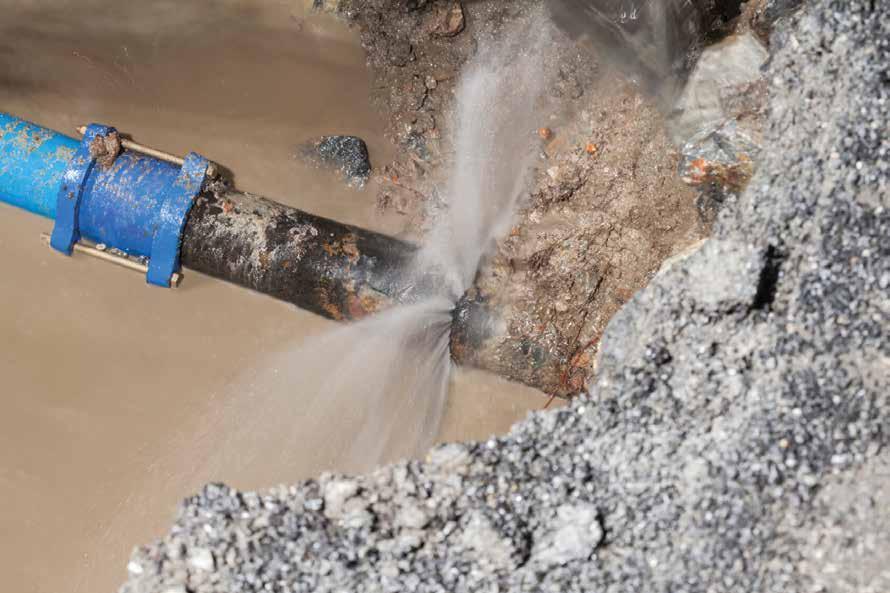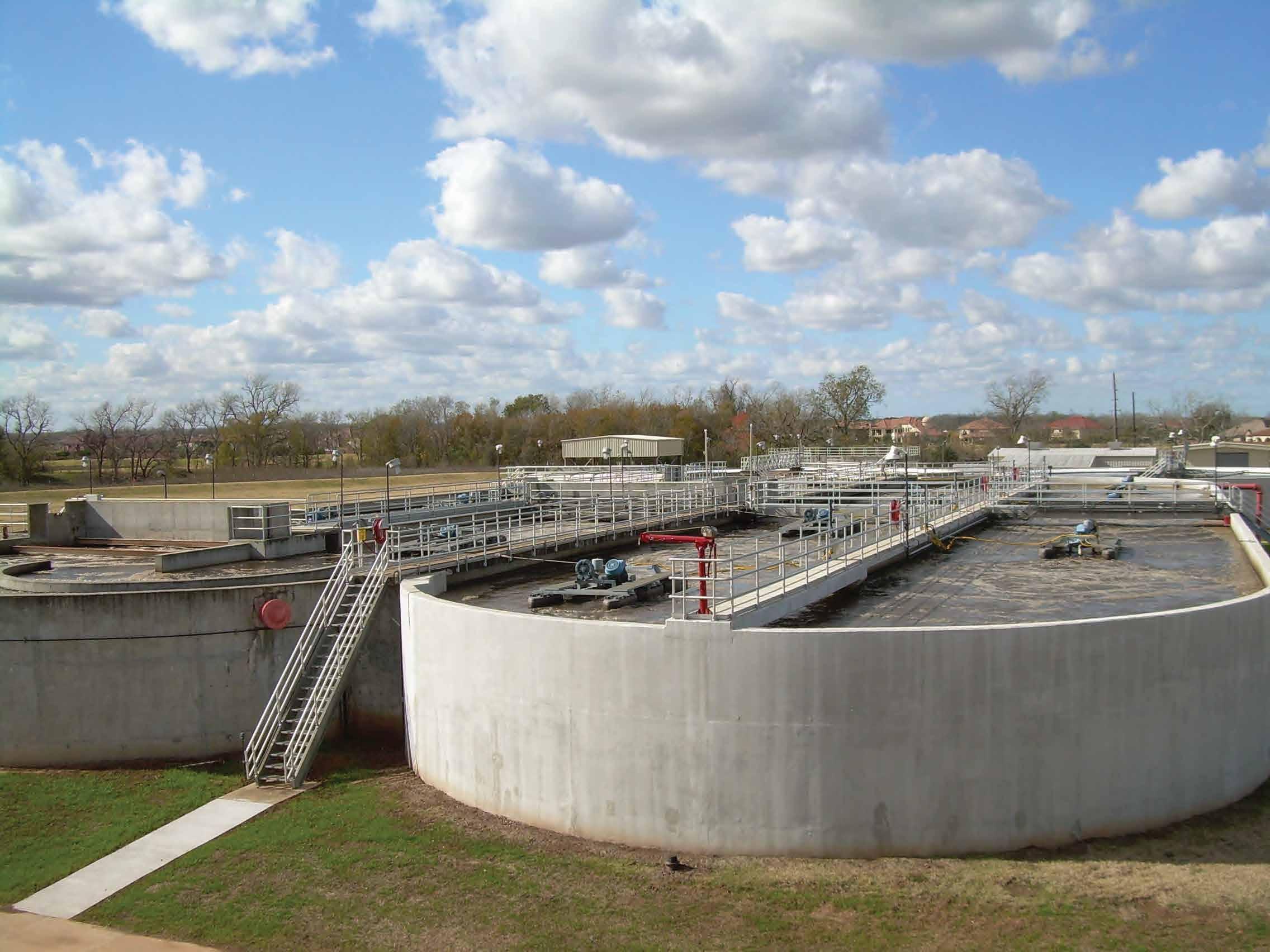

Water & Sanitation Africa
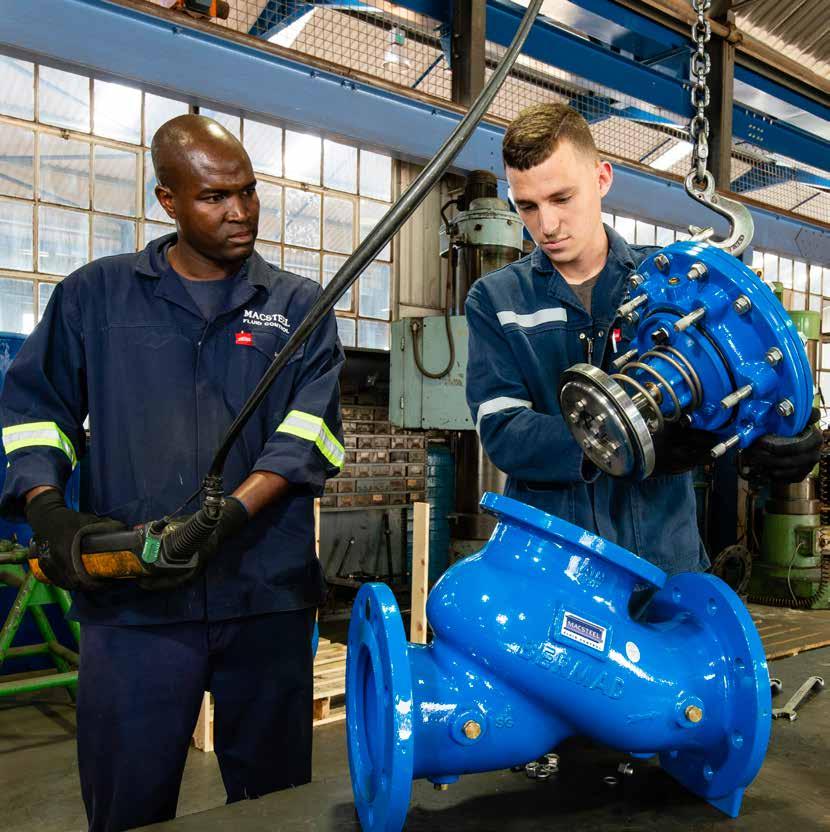
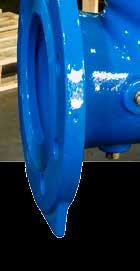

BERMAD GOES LOCAL MACSTEEL
Over the past 30 years, Macsteel and its partner Bermad have been major role players in the Southern African water industry, providing solutions in the municipal, irrigation, wastewater and firefighting industries.



The hydraulic control valve market has undergone many changes over the years, with perhaps the most radical change being the recent Department of Trade and Industry initiative around local content requirements.


As a valve importer, Macsteel Fluid Control opted for a measured approach, to add true value to our suppliers and customers, all the while providing good-quality employment to our valuable staff members. As such, June 2018 will be a landmark point in our relationship with both Bermad and the local market, as we are proud to announce that Bermad is now local. Not only do we comply with the 70% local content regulation by weight, but we have taken the





initiative to introduce Bermad’s latest control valve design –the SIGMA range. This new design optimises and improves the leading flow characteristics already in use with added value to the end user.

The Bermad C70 air valve is also now locally manufactured and adds the powerful Bermad name to this market. Our local manufacturing programme has resulted in Macsteel Fluid Control collaborating in partnership with local service providers. Stringent criteria were put in place such as BBBEE, local sourcing and ISO certification. In addition, emphasis was placed on partnering with small and emerging suppliers and embarking on enterprise and supplier development plans.
Both of these world-class products, combined with the Macsteel reputation for service and dependability, will add huge value to our clients.
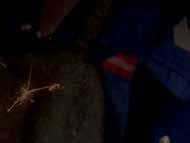









Macsteel Fluid Control has been active in the water industry for over 40 years, supplying a number of wellknown products. now, the company is taking it one step further, manufacturing quality Bermad products locally. P6
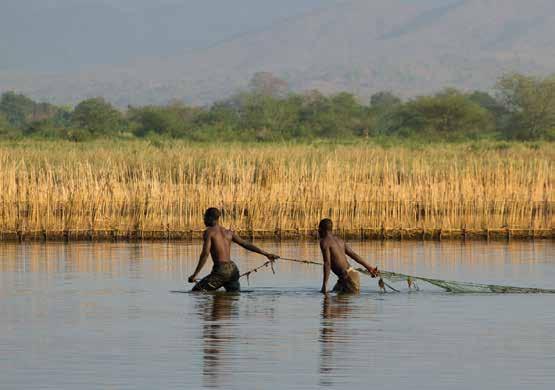

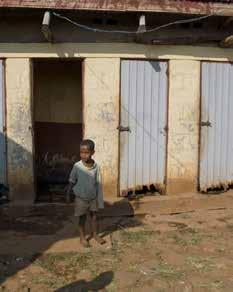

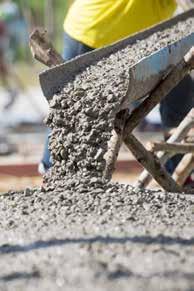
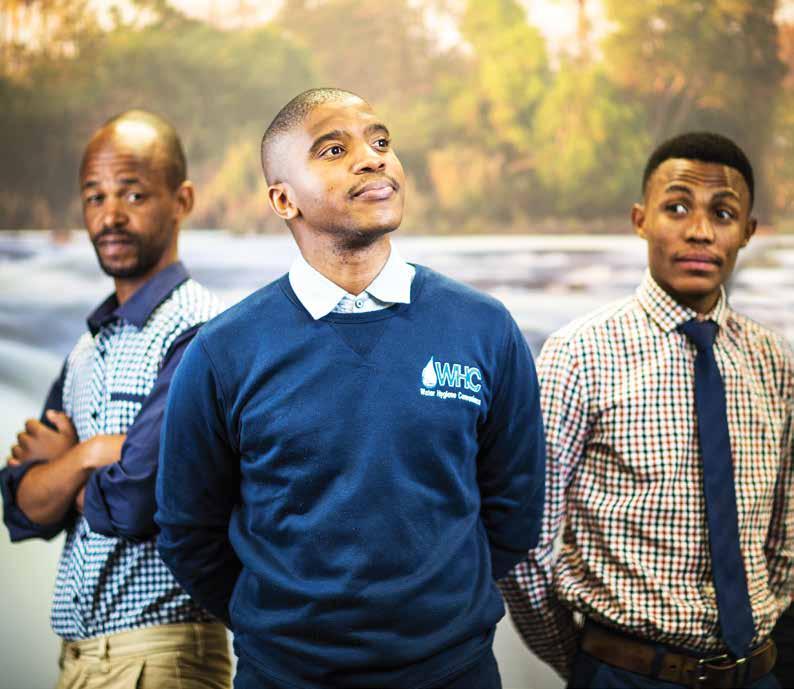


Paseka Lesolang, CEO Wagienience
Publisher Elizabeth Shorten
Editor Danielle Petterson
Managing editor Alastair Currie
Head of design Beren Bauermeister
Chief sub-editor Tristan Snijders
Sub-editor Morgan Carter
Contributors Lloyd Fisher-Jeffes, Lester Goldman, Derek G Hazelton, Valerie Naidoo, Herman Smit, Peter Townshend
Client services & production manager Jayshree Maharaj
Distribution manager Nomsa Masina
Distribution coordinator Asha Pursotham
Financial manager Andrew Lobban
Printers United Litho Johannesburg
t +27 (0)11 402 0571
Advertising sales Hanlie Fintelman
t +27 (0)11 467 6223 | c +27 (0)82 338 2266
h.fintelman@telkomsa.net
Publisher Physical address:
46 Milkyway Avenue, Linbro Park, Sandton, 2090
Postal address:
PO Box 92026, Norwood, 2117, South Africa
t +27 (0)11 233 2600 • f +27 (0)11 234 7274/5 alastair@3smedia.co.za
ISSN: 1990 - 8857
Annual subscription: R330 (SA rate) subs@3smedia.co.za
Copyright 2018. All rights reserved. All articles herein are copyright protected and may not be reproduced either in whole or in part without the prior written permission of the publishers. The views of contributors do not necessarily reflect those of the Water Institute of Southern Africa or the publishers.

WISA Contacts:
Head office
Tel: 086 111 9472(WISA)
fax: +27 (0)11 315 1258
WISA’s Vision Inspiring passion for water
Physical address: 1st Floor, Building 5, Constantia Park, 546 16th Road, Randjiespark Ext 7, Midrand Website: www.wisa.org.za
BRANCHES
central Branch (Free State, Northern Cape, North West)
chairperson: Dr Leana Esterhuizen company: Central University of Technology
Tel: +27 (0)51 507 3850 email: lesterhu@cut.ac.za
eastern cape: chairperson: Christopher Maduma company: Nelson Mandela Bay Municipality
Tel: +27 (0)41 506 7527 cell: +27 (0)82 300 7044 email: citm@live.com
Gauteng chairperson: Ashwin Seetal company: CSIR
Tel: +27 (0)12 841 3477 cell: +27 (0)82 804 2852 email: aseetal@csir.co.za
KwaZulu-Natal
chairperson: Lindelani Sibiya company: Umgeni Water cell: +27 (0)82 928 1081 email: lindelani.sibiya@umgeni.co.za
Limpopo chairperson: Mpho Chokolo company: Lepelle Northern Water cell: +27 (0)72 310 7576 email: mphoc@lepelle.co.za
Mpumalanga
Chairperson: Lihle Mbatha (Acting) Company: Inkomati-Usuthu Catchment Management Agency
Tel: +27 (0)13 753 9000
Email: mbathat@iucma.co.za
Western cape chairperson: Natasia van Binsbergen company: AL Abbott & Associates
Tel: +27 (0)21 448 6340
cell: +27 (0)83 326 3887
email: natasia@alabbott.co.za



Not a drop…
The quality of our surface water resources is declining, largely due to pollution, improperly treated wastewater and even raw sewage.
I recently met with Frik Botha, technical advisor to the Hartbeespoort Rehabilitation Steering Committee, who told me that more than half of the effluent flowing into Hartbeespoort Dam does not come from the 11 wastewater treatment plants that feed into the dam, but from surrounding agriculture and informal settlements, meaning it is untreated (read more on page 14).
If this is happening at Hartbeespoort, then it is likely occurring at many of our other dams, and the consequences for our drinking water could be dire
The ultimate economic enabler
Speaking at a recent WaterAid event, water expert Dr Anthony Turton emphasised the fact that water is the ultimate economic enabler – if we do not get serious about water, we cannot eradicate poverty.
To do this, we need to ensure two things: 1) that we have enough available, usable water; and 2) that our water is adequately treated.
At the event, Belinda Makhafola, directorate: Environmental Health, Department of Health, noted that government needs to be held accountable for the delivery of services. But this raises the question, how can we hold government to account if we aren’t informed?
What happened to Blue and Green drop?
The Blue and Green Drop reports were introduced to facilitate a more transparent way of reporting compliance with water and wastewater requirements, as well as providing citizens with credible information.
However, the most recent reports are from 2014, and even then, only 44 of the 1 036 systems assessed achieved Blue Drop status. A lot can change in five years, and given the lack of investment into our water infrastructure, one could assume that the state of things has not improved.
Encouragingly, Minister of Water and Sanitation Gugile Nkwinti announced late last year that the 2016 Blue Drop Report is expected to be completed by the end of January 2019, while the 2017 Green Drop Report is anticipated in June.
If these deadlines are met, we may be presented with a grim picture of our water quality; however, it will help us to hold government to account and bring about necessary changes in water management.
addressing the problem
Turton argues that roughly R1 trillion is needed to upgrade South Africa’s water infrastructure. This is a significant amount, but as Makhafola pointed out, government is spending more on treating people’s illnesses than on ensuring that water (which in many cases is the cause of illness) is safe to drink.
To address the situation, a few things need to happen. First, government needs to create enabling policies and regulations to allow the public and private sectors to work together more effectively. The distrust between the public and private sectors must be overcome and the latter needs to drive investment and facilitate behavioural change.
There is no shortage of technology, only a shortage of bankable projects. Investing in water will create jobs, grow economies and uplift communities. As Turton stated, “If water is the ultimate economic enabler, then investment into infrastructure becomes the Marshall Plan to eradicate poverty.”



Danielle

More than a valve
Macsteel Fluid Control has been active in the water industry for over 40 years, supplying a number of well-known products. Now, the business is taking it one step further, manufacturing quality Bermad products locally.
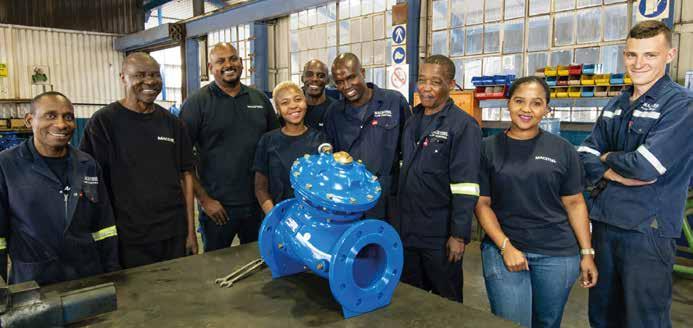
Macsteel Fluid Control is a niche business supplying a comprehensive range of valves, actuators, liquid level gauges, valve interlock systems and a full range of steam products across a number of industries, including water.
Well known as a sole franchise holder in Southern Africa for a number of renowned brands such as Bermad and AMRI, Macsteel Fluid Control has taken a major step towards import substitution with the establishment of a local valve assembly operation.
Local production
In 2011, the Department of Trade and Industry implemented the revised Preferential Procurement Policy Framework Act (No. 5 of 2000) in order to boost local production. This meant Macsteel Fluid Control needed to manufacture at least 70% of its products locally.
Although Macsteel has always assembled its Bermad control valves locally, creating some local content, it did not meet these new requirements.
“Meeting this has been quite a challenge, but we decided we wanted to exceed the 70% requirement. However, we needed to ensure we met the same quality, performance and aesthetic requirements as our imported products,” explains Rowan Blomquist, CEO, Macsteel Fluid Control.
Macsteel Fluid Control has been working closely with its principal, Bermad, for roughly five years to finetune the local casting and assembly of Bermad control and air valves to the necessary standards. “The locally cast product will be exactly the same as the imported product in terms of quality and performance,” Blomquist emphasises.
“We have always supported the local industry through employment, social development initiatives and local
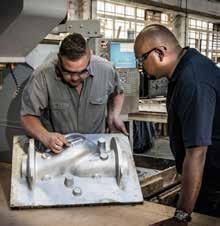
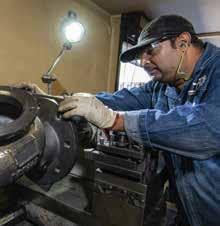
Macsteel Fluid Control has supplied components to a number of large infrastructure projects:
• ±90% of the butterfly valves (AMRI) ranging from 3 inches to 1.6 m for eThekwini Municipality’s Western and Northern Aqueduct projects
• four Amiad filter banks to the Zeitz MOCCA Museum and adjoining buildings – the self-cleaning filters are used to filter and clean raw seawater before it enters the HVAC system
• 400 mm reservoir inlet and level control valves for Magalies Water at the Mafenya Reservoir, controlling flow rates of 1 530 m3/h
• 40 bar to 6 bar pressure-reducing valves for Harmony Gold’s air cooler system.

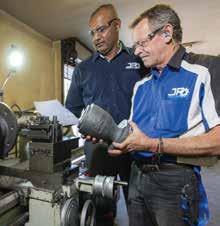
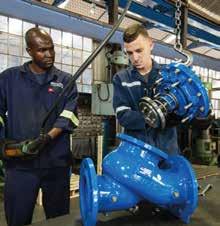

assembly. By manufacturing complete valves locally, which we’ve never done before, we’re taking another step towards building and uplifting our local economy.”
With Bermad’s blessing, Macsteel will roll out its local manufacturing operation to market in the first quarter of 2019.
a strong service base Macsteel Fluid Control prides itself on excellent support and backup service, which it will continue to provide in addition to its local manufacturing offering.
The ISO 9001:2008-certified business has an assembly and test plant in Boksburg, as well as an assembly plant for irrigation products in Cape Town. Macsteel employs three local Bermad product specialists, together with five technicians and an extensive sales team, all of whom have technical knowledge and experience.
“Of our 100 employees, 70% are devoted to sales and backup. We also carry roughly R90 million worth of stock at any given time, much of which is spare parts, to eliminate downtime for our clients,” says Blomquist.
“It is easy to sell a valve. The true test is when the valve fails and you can step in to address the problem in a timely manner. It’s our service and backup that set us apart.”
The business has a network of branches across sub-Saharan Africa and works closely with consultants, offering in-house design services for valve sizing and pipeline design.
a ssisting municipalities with NRW Macsteel Fluid Control works with many of South Africa’s water boards and municipalities, assisting with new installations and upgrades.

“Many municipalities don’t know their infrastructure because they’ve inherited the systems they manage. We work with water utilities to manage their databases and conduct surveys in order to continually repair, update and monitor their networks,” explains Blomquist.
One example is the Royal Bafokeng Nation in North West, with whom Macsteel has been working for six years to maintain and service the municipality’s water reticulation network.
According to Blomquist, the control valve is often the most overlooked part of the water network, often neglected as a case of “fit and forget”. However, he argues that these valves are frequently tampered with, have parts stolen off of them or become damaged, often without the owner’s knowledge. This leads to water loss – a significant problem for a country with a national non-revenue water (NRW) figure of roughly 40%.
By continuously monitoring or surveying water networks, Macsteel Fluid Control is able to detect when control valves are damaged and take action to prevent losses.
The best product offering
The main driving factor behind new valve innovations is reduced costs and longer lifespans.
“As a consumable, every valve has a lifespan. But the goal is to extend that lifespan by offering the right valve for the right application,” explains Blomquist. “We pride ourselves on recommending the right valves for our clients’ applications, and we are confident that the valves we supply offer customers the best quality.
“We’ve often been seen purely as a wholesaler. However, we are more than just valve stockists. We offer on-site service, testing, manufacturing, troubleshooting and more, and we’re on our way to becoming Africa’s leading valve supplier.”

Cultivating resilience
Nature and our environment are inherently resilient. The natural water cycle does a wonderful job in managing the world’s water but, unfortunately, we disrupt this cycle, particularly through our modern cities.
Dr Lester Goldman

cities disrupt the natural water cycle in a myriad of ways, most notably through changes in land use, climate change and urbanisation. In 2017, around 65% of South Africa’s population lived in urban areas and cities. This certainly has a tremendous impact on our environment, and we join many countries in struggling to meet global agreements on climate change and keep global temperature rises to less than 2°C. Climate change and the rapid growth of cities have left us facing the challenges of extreme flooding and drought. Finding ways to build resilience to these extremes is essential to the long-term sustainability of our communities, the environment and the economy.
At WISA, we are committed to having the required discussions in our branches, divisions and empowerment platforms. We have committed to, and undergone, the required governance changes to ensure that we are empowered as an organisation to deal with these crucial issues.
Building WiSa’s resilience

Organisational resilience is defined as “the ability of a system to withstand changes in its environment and still function”. It is a capability that involves organisations either being able to endure environmental
changes without having to permanently adapt, or being forced to adapt to a new way of working that better suits the new environmental conditions.
Good governance and organisational sustainability allow one the freedom to focus on strategic issues, and this is especially true in a membership body like WISA. We want to focus on our vision –‘Inspiring a passion for water’ – knowing that the organisation is sound and well governed. However, we also need to know and understand the strategic issues facing the water sector; this we can only do with your input and involvement, as a WISA member.
Join our various organisational structures and influence the strategic inputs they discuss, as these will filter through and influence WISA’s overall organisational strategy. We will continue to host events that create forums for such discussions, and we want to ensure that these happen locally, with more frequency.
Importantly, these forums should consist of more than just WISA members, and we intend to invite relevant stakeholders – to account, listen, understand and commit. This is the required sectoral environment we must create. We are not ignorant or naïve to these challenges, but to quote the 14th Dalai Lama, Tenzin Gyatso: “Change starts with us as individuals. If one individual becomes more compassionate, it will influence others and so we will change the world.”
Building on successes
During 2018, WISA moved towards
improving its governance and compliance, and I can now proudly state that the WISA Memorandum of Incorporation is compliant with the Companies Act (No. 71 of 2008) and the King 4 Code of Good Governance (the most relevant legislation for a non-profit).
We also achieved our ISO 9001:2015 certification during 2018, which proves our commitment to continuous improvement, and client care. In addition, our annual membership survey, while confirming overall member satisfaction, also allowed valuable feedback from members, guiding us on areas for improvement, and providing insight on strategic focus areas.
We hosted a successful biennial conference in Cape Town, during June 2018, and built upon the success and feedback of prior WISA biennials. We also started rolling out our CPD training last year, and we are very excited by the response from our members and the sector.
Of course, we can never satisfy everyone, and we strive to improve continuously where we fall short. The WISA staff are committed to always treating everyone with respect and professionalism, as demanded by the WISA values we all commit to.
Please check our online calendar for exciting events happening close to you during 2019.
I wish you all a very successful year, encourage you to become more involved with WISA, and help us change the organisational and natural environment we love so much.
Dr Lester Goldman, CEO, WISA
Our water journey
The new year always brings an opportunity to reflect. Life, after all, is a journey of what we aspire to, what we set out to do, what we achieve, what we experience and the lessons we take with us, hopefully making us better people, professionals, companies, institutions and associations. Dr Valerie Naidoo.
For WISA, 2018 was a year of getting some of our legal paperwork in order.
An example of this is the Memorandum of Incorporation (MoI), which will provide effective governance for the association and lead us into a phase where strategy is driven as a collective passion around core issues that uplift all of us, including the people we serve. Thank you to all the members who attended the workshops and the AGM for their input and positivity around this and other issues.
In 2018, we also successfully hosted the WISA Biennial Conference and Exhibition in Cape Town – a city where water discussions had been highlighted and emphasised due to the drought in the province. Thank you to all the members
and participants who attended, presented and volunteered – your continued support is always warmly appreciated. Thank you to the organising and technical committees for their time, effort and sacrifice. Thank you also to the head office and the local organising committee of the 2014 conference held in Durban for sharing their lessons and improving the processes. I truly believe that WISA is improving its efficiencies around hosting events, as we become a smart association with a strong learning culture.
Sadly, though, a major disappointment was the lack of support from the City of Cape Town itself, as well as the National Department of Water and Sanitation, not from a monetary perspective, but in their unwillingness to approve attendance to the conference for
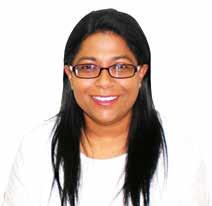
Dr Valerie Naidoo, chair, WISA
technical professionals in the water sector. It is important that municipal managers and politicians recognise the importance of learning, networking and growing the technical competence of all water sector professionals. To those WISA members who attended despite the difficulties, I salute you for your passion and commitment.
Notable achievements
In 2018, WISA received its SABS ISO 9001:2015 accreditation and, in September 2018, SAQA renewed the recognition of WISA as a professional body and registered the following professional designation on the National Qualifications Framework: Professional Process Controller (Pr PC Water). These are wonderful accomplishments from head office as we strive for excellence, relevance and value for our members. I hope that the latter accomplishment in particular allows us to further accelerate training and


designations to the process controllers in the water sector. For this to take effect, we will need a vibrant and willing Process Controllers Division.
ensuring effective leadership
The WISA board made a few promises at the AGM in Cape Town. We spoke about how the new MoI allows for the strengthening of all processes, which should lead to transparent and consistent policy and messaging, thereby leaving no member willing to volunteer behind.
To this effect, the board has been busy approving several key processes for WISA,
all of which will contribute to responsible and ethical governance of the association. We now have an updated board charter to ensure accountability, effectiveness and prevent abuse of power.
All board committee terms of reference have been relooked and the necessary new committees created to make the board more effective in carrying out its duties. These include a remuneration committee and a nominations committee to provide oversight and representation for incoming board members.
In addition, we have consulted, reviewed and updated the terms of
reference for our divisions, branches and empowerment platforms. These documents help to strengthen the board, divisions, branches, empowerment platforms and WISA, thereby shifting us from individual camps to providing oversight for all members, as well as allowing us to achieve our strategic goals.
In 2019, we will be issuing a call for nominations for three new board members, ensuring we fulfil approved criteria of gender, diversity, skills and experience. We expect to have these new board members approved by WISA members by March 2019.
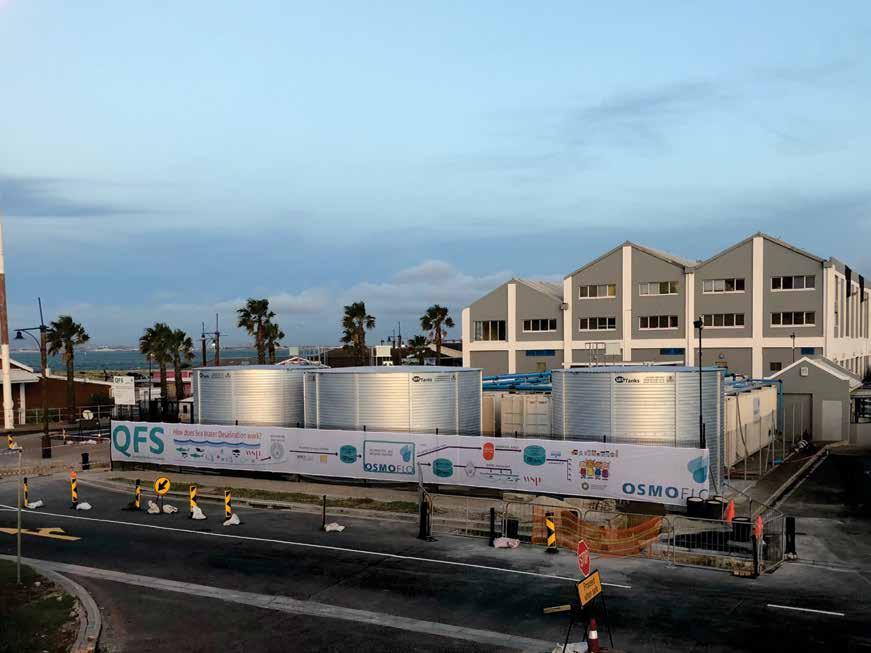


Contributing to global change
The conference, themed ‘Sustainable futures through science and innovation’, provided a platform for networking and knowledge-sharing among global change stakeholders. The event brought together representatives from the research and development sector, business, industry, government, and civil society, to share and debate the latest research, technology and other strategic solutions to the Global Change Conference.
The YWP-ZA event took place on Monday 3 December 2018, with a total of 53 delegates in attendance, the majority being students from the universities of Fort Hare and KwaZulu-Natal.
The event focused on tips and best practice for writing a scientific paper.
Ivo Arrey, former YWP-ZA Limpopo chair and final-year PhD student, kick-started the session by highlighting the why, where, who and how on publishing a scientific paper. This was followed by group discussions
Delegates in groups reporting on lessons learned in writing good scientific papers

The YWP-ZA Limpopo chapter ended the year on a high note by hosting an event at the 4th National Global Change Conference held from 3 to 5 December 2018 at Bolivia Conference Centre, Polokwane.
around topics from the YWP-ZA publication booklet.
a successful event
Overall, the event was a success.
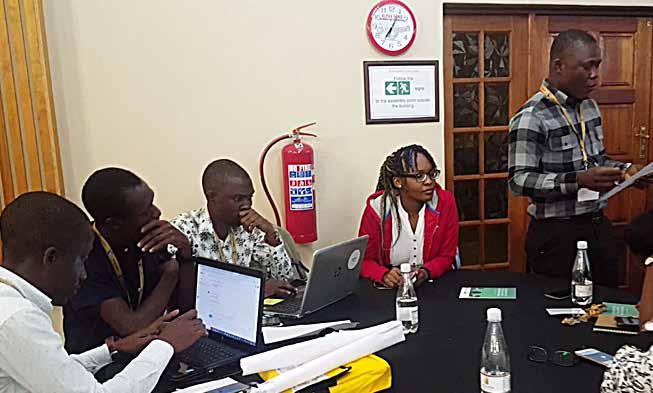
YWP-ZA Limpopo team at the 4th National Global Change Conference 2018 (L to R): Vuledzani Maiyana, chairperson; Pfananani Ramulifho, coordinator; Ivo Arrey, outgoing chair; and Lufuno Matsheketsheke, secretary
Outside of the usual scientific writing courses offered by universities, YWP-ZA found that this event provided a good platform for students from various universities to share lessons learned from their own experiences at their respective institutions.
Some delegates found commonality in others’ challenges and successes, while some learnt a new approach to engaging with their research and peers. This highlights the benefit that these kinds of events offer to young professionals and the sector – a diverse platform of open dialogue to learn and grow by sharing information.
The delegates showed a keen interest in understanding the dos and don’ts of publishing, and demonstrated commitment to furthering their abilities through scientific research
Consistent quality requires consistent excellence ...
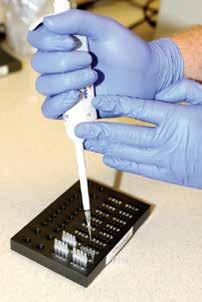


... in every area of wastewater management.
Serving both the public and private sectors, ERWAT promotes a healthy environment by providing cost-effective wastewater treatment solutions through innovative technologies. It specialises in sustainable, quality wastewater services, backed by focused technical, maintenance and engineering services. An ISO/IEC 17025 accredited laboratory renders a wide variety of specialised analyses, while industrial wastewater quality management assessments and advice are also offered.
East Rand Water Reg. No. 1992/005753/08
(Association incorporated in terms of section 21)
GPS Co-ordinates:
Address: Hartebeestfontein Office Park, R25, Bapsfontein/Bronkhorstspruit, Kempton Park.
Tel: +27 11 929 7000
E-mail: mail@erwat.co.za
www.erwat.co.za


and contributing to the scientific knowledge base of the South African water sector.
Plans for 2019
Looking into the new year, YWP-ZA – together with the WISA Limpopo branch – will be hosting open days in early 2019 at the University of Venda and the University of Limpopo. These events will be used to introduce new students to WISA, as well as provide information and possible opportunities in the water sector. Students will also be given information on how they can volunteer and get involved in WISA and YWP-ZA. Visit www. ywp-za.org for dates and times.
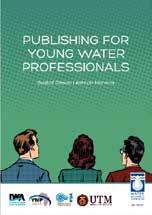
ABOVE A YWP-ZA booklet on publishing by Gustaf
Olsson and Ashton Maherry
RIGHT Delegates participating in group discussions

YWP-ZA would like to welcome Roelof Coertze as the new lead for the YWPZA North West region.
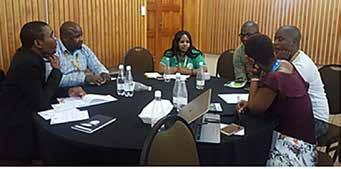

A new Lead for North West
Roelof Coertze is a PhD candidate at the North-West University in the field of environmental health, focusing on molecular microbiology and bioinformatics. Coertze is also an entrepreneur and has two unofficial businesses in photography and the design and writing of laboratory information management systems (LIMS).
Coertze says he is looking forward to expanding the role of the YWP in the North West province, and various
initiatives are being planned with this goal in mind. Examples of some of the exciting projects that can be expected include creating community awareness around the importance of water and water hygiene in urban and rural settings, academic literacy workshops, the role of water in various industry environments, and partaking in global initiatives such as Antibiotic Awareness Week and Water Week. For more information about Coertze and other YWP-ZA members, visit www.ywp-za.org.
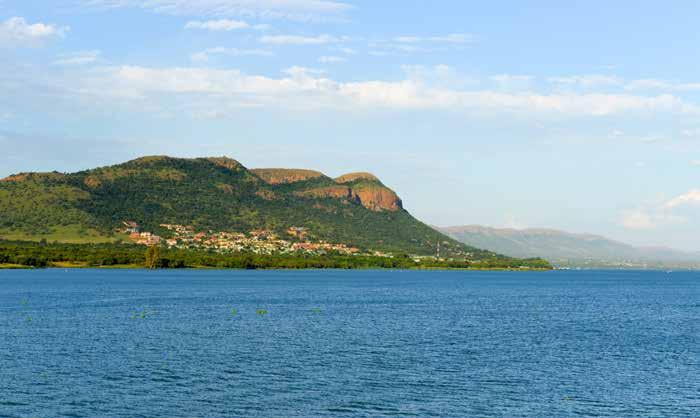
Many experts believe that we have past the tipping point on climate change, which brings with it more severe weather patterns for the entire globe. Wetlands offer a natural solution, playing a significant role in stabilising greenhouse gas emissions and blunting the impacts of climate change.
despite the efforts of the Paris Agreement, the levels of carbon dioxide (CO2) in our atmosphere have increased by 40% since pre-industrial times. Coupled with increased methane and other greenhouse gas levels, the result is a rise in global temperatures and sea levels rising faster than ever recorded.
However, wetlands can help us prepare for, cope with and bounce back from the impacts of climate change.
a natural solution
This World Wetlands Day the focus is on ‘Wetlands and Climate Change’.
Over the past 35 years, the frequency of natural disasters worldwide has more than doubled. Of these, 90% are water-related and more extreme weather is predicted going forward. But wetlands could be the key to coping with climate change.
Inland wetlands such as flood plains, rivers, lakes and swamps function like sponges, absorbing and storing excess
We lose wetlands three times faster

A natural solution

rainfall and reducing flood surges. During dry seasons, wetlands release this stored water, delaying the onset of droughts and minimising water shortages.
Furthermore, coastal wetlands such as salt marshes, mangroves, seagrass beds, and coral reefs act like shock absorbers. They reduce the intensity of waves, storm surges and tsunamis, shielding the 60% of the global population who live and work along coastlines.
More directly addressing climate change, peatlands, mangroves, and seagrass store vast amounts of carbon. In fact, wetlands are the most effective carbon sinks on earth. Roughly 3% of the earth’s landmass comprises peatlands, which store approximately 30% of all landbased carbon – double that stored by the world’s forests.
The decline of wetlands
Wetlands hold huge potential: they can provide water, offer protection from natural disasters, and provide food and livelihoods to millions of people. They support biodiversity and store more carbon than any other ecosystem. However,
BELOW LEFT Peel-Yalgorup system, Australia (Credit: David Rennie)
BELOW RIGHT Fisherman on boat in Inle Lake, Myanmar (Credit: Atsushi Tanabe)

in
according to Ramsar, the tremendous value of wetlands remains largely unrecognised by policy- and decision-makers.
Unfortunately, as much as 87% of the global wetland resource has been lost since 1700. The negative impacts on the quality and availability of water, food security, biodiversity and carbon sequestration are direct and measurable, and wetlanddependent species are in serious decline.
Furthermore, the quality of remaining wetlands is suffering as a result of pollution, invasive species, unsustainable use, disrupted flow regimes and climate change.
According to the 2018 Global Wetlands Outlook, the world’s remaining natural wetlands cover only a fraction of their original area. And while artificial wetlands have increased since the 1970s, often replacing natural wetlands, these are still relatively small compared to natural wetlands.
Wetlands have declined by 35% since 1970

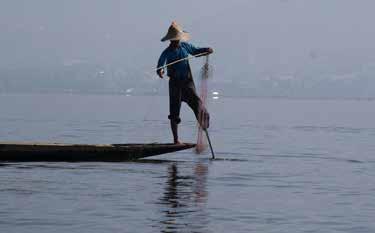
LEFT Fishermen
Elephant Marsh, Malawi (Credit: Dr Katherine Forsythe)

South Africa has 23 Ramsar wetlands

The importance of conservation
Given the crucial role that these water bodies can play, it is important that strategies addressing climate change include the wise use of wetlands.
However, conserving our wetlands is even more vital, especially since wetlands transition from being carbon sinks to carbon sources when drained or burned for agriculture. This releases centuries of stored carbon into the atmosphere. In fact, CO2 emissions from drained and burned peatlands equate to 10% of all annual fossil fuel emissions.
Furthermore, the changing temperature and precipitation regimes that climate change brings can shift the balance of the processes that lead to carbon sequestration. This can also cause wetlands to become carbon sources, and the 2018 Global Wetlands Outlook states that higher temperatures under climate change are expected to increase greenhouse gas emissions from wetlands.
Success stories
The importance of wetland conservation was recognised in the 1970s by
the Convention on Wetlands – an intergovernmental treaty that provides a framework for national action and international cooperation for the conservation and wise use of wetlands and their resources. Known as the Ramsar Convention, the treaty came into force in 1975 and almost 90% of UN member states have become contracting parties since. There are currently several ongoing projects to protect and restore wetlands. In Europe an intensive restoration of the Nordic-Baltic region’s peatlands is underway. This forms part of the Nordic Council of Ministers’ (representing Denmark, Finland, Iceland, Norway, and Sweden) commitment to preserving peatlands for climate change regulation.
The council is working to restore the 45% of the peatlands in Nordic and Baltic countries that have been drained and are now responsible for almost 25% of the region’s total annual CO2 emissions. More than 20 000 ha have already been restored on the path to returning the Nordic-Baltic peatlands to being carbon sinks and
The majority of the global soil carbon pool is held in wetlands

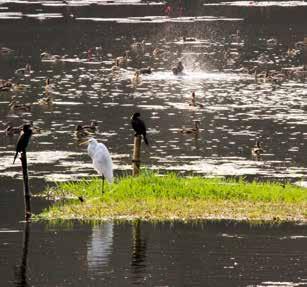
ABOVE LEFT The scenic Lake Sebu in the Philippines is a prime eco-tourism destination and source of livelihood for the area (Credit: Erickson Tabayag)
ABOVE A wetland in Dhaka, Bangladesh, supports many bird species (Credit: Shahriar Aman)
helping to limit greenhouse gases in the atmosphere.
In West Africa, the world’s largest mangrove reforestation project is under way in Senegal. The projects aims to plant 79 million mangrove trees on more than 10 000 ha, helping to restore a portion of the 45 000 ha that have been lost since the 1970s.
The restored wetland is expected to benefit 200 000 people in 350 local villages by storing 500 000 tonnes of CO2 over 20 years, as well as protecting coastal areas against storms and producing up to 18 000 extra tonnes of fish annually.
These are just 2 of the more than 2 200 Ramsar sites across the world that cover more than 2.1 million km2. Ramsar and its contracting parties continue to develop and maintain an international network of wetlands for the conservation of global biological diversity and for sustaining human life through the maintenance of their ecosystem components, processes and benefits.
BULK WATER S TORAGE SOLUTIONS
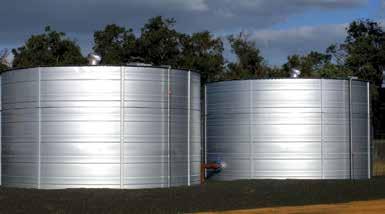

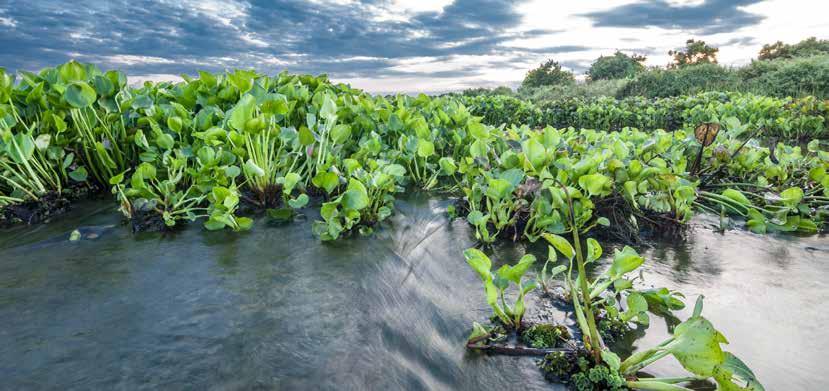
Water hyacinth: blessing or curse?
The 95-year-old Hartbeespoort Dam has been plagued by water hyacinths since the 1970s. However, there may be a way to harness these alien invaders to empower local communities and start a circular economy. By
Danielle Petterson
The water quality in the Hartbeespoort Dam began to decline noticeably in the 1960s as the population in South Africa’s largest metropole began to boom. Today, the effluent from 11 wastewater treatment plants feeds into the dam via a number of rivers, often carrying a high phosphate and sediment load. Although the legal limit for phosphate in effluent is 1 mg/ℓ, this is often exceeded, resulting in eutrophication.
More concerning, Frederick Botha, technical advisor, Hartbeespoort Rehabilitation Steering Committee (HRSC), states that research shows that only 47% of the effluent in the dam comes from these treatment plants, while the remaining 53% comes from non-point sources; essentially contaminated effluent from surrounding agriculture, informal settlements, and other anthropogenic activities. Botha goes so far as to refer to Hartbeespoort Dam as Gauteng’s biggest sewage canal, comparing it to a maturation pond.
As a result of the inflow of effluent, the water quality in the dam began
deteriorating from eutrophic to hypertrophic in 1960. These high phosphate levels feed water hyacinth and, in 1977, the dam was invaded by these alien plants (originating from South America), which covered 70% of the dam’s 2 000 ha surface area.
At the time, the Department of Water Affairs took action, spraying the hyacinths with herbicides, resulting in roughly 400 000 tonnes of plant matter sinking to the bottom of the dam. However, over time, this posed a new problem: the plants began to anaerobically digest, releasing biomass nutrients into the water. The result was an explosion of cyanobacteria, which had never been prevalent in Hartbeespoort Dam prior to this.
During the 1980s, the cyanobacteria caused a number of Blue Green Algae bloom incidents and, in March 2003, an emergency was declared when the algae formed a hyper scum, covering a large portion of the dam surface. When the cyanobacteria begin to fight for oxygen, they release a cyanotoxin to kill each other. This toxin is not removed by most
LEFT One hectare of water hyacinth can remove roughly 1.8 tonnes of nitrogen and 0.3 tonnes of phosphorus
water treatment plants and can attack the liver. Botha describes it as the biggest problem for drinking water safety on Hartbeespoort Dam.
controlling the bloom
In 2006, the Department of Water Affairs launched the Metsi-a-me programme to remove algae and hyacinths and improve water qualityin Hartbeespoort Dam. Botha says this produced very promising results and the water hyacinth was kept under control until 2014 when the department abandoned the programme due to budget limitations.
Between 2014 and 2017, the problem escalated and in 2017 the Hartbeespoort community stepped in and formed the HRSC to address the issue. At the time, hyacinth covered 33% of the dam.

The focus of the HRSC was to take short-term action to eradicate the water hyacinth, while in the long term aiming to manage the hyacinth infestation without herbicides, protect the dam’s biodiversity, investigate the sustainable use of water
Hartbeespoort Dam has been plagued by water hyacinth since the 1970s

hyacinth to create jobs and business opportunities, as well as to reverse the hyper eutrophication in the dam.
Having obtained a permit from the Department of Environmental Affairs, the committee, together with contractors and shoreline owners, began harvesting the water hyacinth in 2017. This proved extremely successful and roughly 200 000 tonnes of plant matter was removed and transformed into compost. Water hyacinth weevils were also introduced to help naturally curb the growth of the plants. As a result, the water in the dam is currently considered mesotrophic and of a good quality.
Botha has been monitoring the state of the dam and the activity of the hyacinth through a series of satellite mapping tools such as Sentinel Hub and EONEMP, provided by CyanoLakes (PTY) Ltd. The water hyacinth coverage in Hartbeespoort Dam is now around 15%, and in the past has reached levels lower than 10% since the introduction of the HRSC strategy. However, the harvesting operations are costly and the committee is now finding itself hampered by a lack of funds.
from challenge to opportunity
In an effort to develop a long-term solution, Botha began to research options such as a pre-dam to act as a barrier to remove phosphates before they enter the Hartbeespoort Dam. He has since shifted his focus to phytoremediation – the use of living plants to remove contaminants in the water.
This ‘paradigm shift’ would see water hyacinth being used to remove excess nutrients from the dam before being

harvested and converted into organic fertiliser for the local agricultural sector.
Due to the rapid growth of water hyacinth, nutrients found in eutrophic water resources such as nitrogen and phosphorous can accumulate in the plant tissue. One hectare of water hyacinth can remove roughly 1.8 tonnes of nitrogen and 0.3 tonnes of phosphorus. Other pollutants such as potassium, magnesium, cobalt copper and iron are also captured in the plant tissue, and readily removed if the hyacinth is harvested.
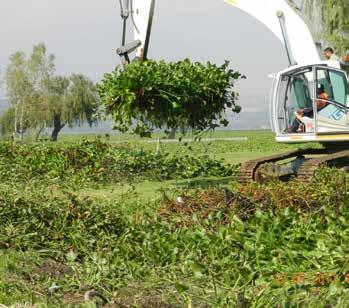
Phytoremediation is already being done in China, where the growth of hyacinth is controlled to reduce nutrients and improve water quality, before being harvested in rotational cycles. Building on this model, Botha is focusing his research on the controlled growth and utilisation of water hyacinth in the Hartbeespoort Dam. In addition, he will explore the resource allocation of water hyacinth to produce organic fertiliser and other value-added products by utilising a unique hyacinth harvesting and conversion technology. Botha’s model, which is still a work in progress, uses aerobic fermentation to produce fertiliser in just a week. HyaTech RSA will utilise the new technology in a demonstration project.
Botha argues that a successful demonstration project can be a model for effectively implementing a business that could save billions of rands, which
would be needed to upgrade wastewater treatment infrastructure to cope with the increased nutrient load. It also provides job and business creation opportunities, which can empower local communities to start a circular economy, while helping the communities around the dam to live healthier lives.
conclusion
Water hyacinth is one of the world’s most prevalent invasive aquatic plants and is known to cause significant ecological and socio-economic change. However, research to date shows that there are minimal ecologically negative effects associated with the plant’s presence, provided the water hyacinth cover is kept under control. Nutrient pollution remains a major threat to the water quality of Hartbeespoort Dam and could lower property values, hinder recreation, degrade drinking water quality and affect irrigation for the surrounding agricultural industry reliant on the dam. If the invading water hyacinths can be controlled and managed, it could be beneficial to water quality, while creating by-products to uplift the local economy.

The original Hartbeespoort Rehabilitation Steering Committee
Hyacinth harvesting operation under way

Go for Lesotho Highlands Phase II
The Lesotho Highlands Development Authority has begun awarding tenders for Phase II of the Lesotho Highland Water Project, with measures in place to address the challenges faced in Phase I.
after years of delays, construction on Phase II of the Lesotho Highland Water Project (LHWP) is finally under way.
The award-winning, multibillion-rand project is one of the largest ongoing development projects in the world. It was designed to include five phases, implemented over a 30-year period, to ultimately transfer about 70 m3/s of water to Gauteng. However, more than 30 years later, only Phase I has been completed.
According to Tente Tente, divisional manager: Phase II, Lesotho Highlands Development Authority (LHDA), Phase I is already delivering an average of 25 m3/s, with Phase II expected to add an additional 15 m3/s. Further phases will add the remaining 30 m3/s.
Phase ii works
Phase II of the LHWP was launched in 2014, with close to 30 contracts having been awarded across various disciplines for this phase.
Approximately R25 billion will be spent on the water transfer component of Phase II, which entails the construction of Polihali Dam, a transfer tunnel from Polihali to Katse Dam, advanced infrastructure, as well as environmental and social development programmes in Lesotho.
This phase will also include a pump storage scheme to generate 1 200 MW, associated transmission lines, and appurtenant works, by utilising the existing Katse Reservoir as the lower reservoir and a new upper reservoir in
the Kobong Valley, or any other similar scheme close to Katse Dam. Both the water transfer and hydroelectric components are expected to be commissioned in 2026 in line with the revised timelines.
contracts awarded
The construction of advance infrastructure at Polihali and Katse has now begun.
The LHDA awarded the first construction contract for the Polihali north-east access road to the Sinohydro SA/Nthane Brothers JV, comprising South African-registered Sinohydro and Lesotho-registered, Maseru-based Nthane Brothers.
The R235 million Polihali north-east access road is one of the critical advance infrastructure components of Phase II, the majority of which must be completed prior to the construction of the main Phase II works – the Polihali Dam and transfer tunnel.
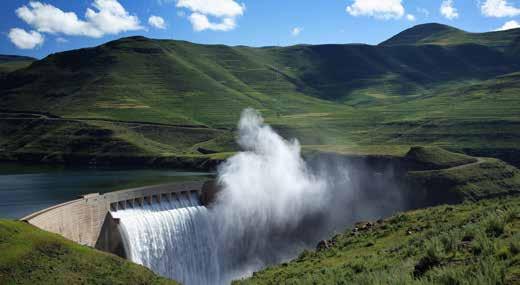
The contractor began work on the 20-month contract in November 2018, marking the start of Phase II’s six-year construction period.
The LHDA has also awarded the contract for the design, supply and installation of its temporary site offices and accommodation units at Tlokoeng, Mokhotlong, to the Senqu Hi-Way Partnership. Work on the contract commenced immediately, with construction expected to be completed by June 2019.
TABLE 1 LHWP Phase II programme
In line with the tendering strategy to achieve the policy objectives of the Phase II agreement, construction works for advance infrastructure is restricted to contractors registered in Lesotho or South Africa.
addressing past challenges
According to Tente, the LHDA is working to restore its credibility after Phase I of the project came under fire for corruption. “We need to restore the project credibility and the trust of the project principals and other key stakeholders,” he says.
A project management unit has now been established to assist the LHDA with the implementation of Phase II. This will be backed up by effective reporting to key stakeholders, as well as anti-corruption and whistleblowing policies. “We are trying to ensure that all our processes can stand up to scrutiny,” asserts Tente.
The Phase II agreement between Lesotho and South Africa has also incorporated a number of key elements relating to procurement; namely that it should foster competitiveness, transparency, cost-effectiveness and quality.
Provided these elements are met, preference will be given, in descending order, to companies from: Lesotho, South Africa, the SADC region, and beyond. According to Tente, firms from Lesotho and South Africa will share the value
of all infrastructure work equally on a monetary basis, taking into account aspects such as shareholding and operational experience.
When it comes to the recruitment of personnel, preference will be given in the same order, provided the required skills and experience is met. “Suitably qualified and experienced personnel are the key. It is also important to have robust reporting and auditing processes with the appropriate delegation of authority,” says Tente.
Reliable water supply for Sa
Once completed, Phase II of the LHWP is expected to ensure a reliable water supply to South Africa by 2025, progressively increasing the current supply rate of 780 million m3/year to more than 1 270 m3/year. At the same time, it will increase the quantity of electricity generated in Lesotho and is a further step in the process of securing an independent electricity source to meet Lesotho’s domestic requirements.












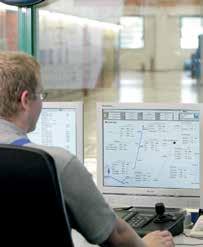























Advanced process automation and quality monitoring in drinking or sewage water facilities
Process analysis for the water and wastewater industry –technology driven by KROHNE
• Extensive portfolio of analytic sensors, also with integrated transmitter technology, and complete measuring systems
• Reliable analysis of parameters directly in the process, e. g.:
– pH, conductivity, dissolved oxygen, turbidity, temperature
– sedimentation monitoring, sludge zone tracking
• Mounting assemblies and accessories, approvals from drinking water to Ex
• Wide range of mounting assemblies and accessories



KROHNE South Africa
8 Bushbuck Close, Corporate Park South Randjiespark, Midrand, Tel.: +27 113141391
Fax: +27 113141681, Nirisha Harinarain, n.harinarain@krohne.com, www.za.krohne.com
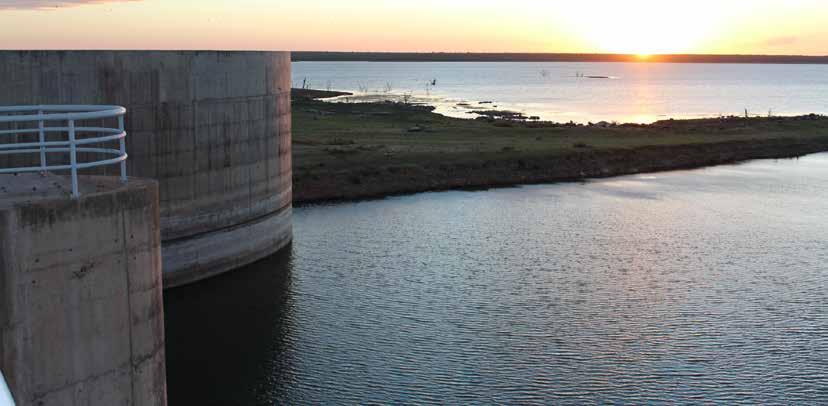
When one of Mozambique’s largest dams experienced a bursting failure of its bottom outlet conduits, a team of experts had to collaborate to develop solutions to make Massingir Dam safer, while maintaining its full functionality during construction.
Massingir Dam is a 48 m high, 4.8 km long embankment dam on the Elefantes River, a tributary of the Limpopo River in the southern Gaza province of Mozambique.
On 22 May 2008, a sudden massive bursting failure of the downstream portion of the dam’s bottom outlet works resulted in the uncontrolled discharge of approximately 1 000 m3/s of water, causing significant damage. The elevated, reinforced-concrete control rooms for the hydraulic cylinders that lifted the downstream radial gates were destroyed and the discharge was eventually stopped after a period of two days by closing the emergency intake gates.
Aurecon was appointed to investigate the cause of failure and undertake the design and supervision of the rehabilitation works.
failure and rehabilitation
The dam’s bottom outlet works consist of two 8 m x 8 m horseshoe-shaped conduits with a 9 m diameter circular conduit above, intended as a future power penstock. These were constructed as a triple-barrel, reinforced-concrete structure
Rehabilitating Massingir Dam
in a cut-and-cover trench into the limestone and sandstone formations on the right of the main channel of the river. Downstream of the triple-barrel section, the outlet consists only of the two horseshoeshaped conduits.
The bottom outlet structure of the Massingir Dam failed when a blow-out occurred in the downstream part of the dual conduit. This was due to the increased hydrostatic pressure generated as a result of the increase in the upstream reservoir level, following the installation of crest gates on the spillway.
Aurecon concluded that deficient reinforcement detailing was the main cause of the failure, identifying the mechanism of the failure as the main tensile reinforcement pulling out of the concrete on the curved inside faces. It also became apparent that once a failure started in a small ‘trigger’ area on a poorly prepared construction joint, a progressive failure would have occurred very rapidly.
This was evidenced on-site by the extensive amount of reinforcement that had been peeled off but not fractured, and the many concrete surfaces from which the reinforcement had clearly pulled away. Hydrostatic pore pressures within the concrete were therefore prioritised.
The only practical method of restoring the integrity of the conduit – to ensure that it would be able to withstand hydrostatic pressures – was to install a 6 400 mm ID steel liner in each of the existing 8 m horseshoe-shaped, reinforced-concrete outlet conduits.
While various solutions were investigated, lining the bottom with steel proved the most practical method of reinstating the integrity of the conduit, while also being able to withstand any external pressures acting on it and seal any leaking joints. It also ensured structural stability and prevented piping of fine material from the core of the embankment into the conduits, which could lead to failure of the embankment in the long term.
In addition, rehabilitation included the installation of hydropower offtakes, mass and heavily reinforced infill concreting and grouting, rehabilitation of the two downstream radial control gates (including the replacement of all four structural steel A-frame arms of the radial gates), as well as entirely new hydraulic, electrical equipment and computerised control and
project team
Client: Mozambique National Directorate of Water and Regional Administration of Water South (ARA-Sul)
Design: Aurecon South Africa
Construction supervision: Aurecon Mozambique, LDA
Main contractor: CMCRA/CMC AA
Joint Venture
Subcontractor: ATB Riva Calzoni

Massingir Dam
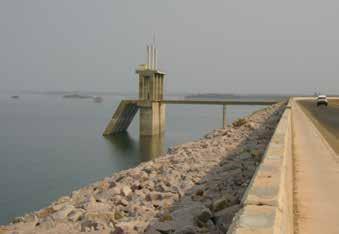


instrumentation equipment for operation of the bottom outlet works.
The design also allowed the potentially unsafe original 9 m hydropower conduit to be retired. The hydropower potential of Massingir Dam could be retained, and its flexibility improved from a single hydropower offtake to two 3 700 mm diameter steel offtakes (for future use) provided for in the new steel liners.
Mitigating risks
Funded by the African Development Bank and the Government of Mozambique, the project enhanced the safety of the dam and rendered it fully operational again, increasing its capacity to supply downstream irrigation demands and thus enhancing the local economy.
The rehabilitation project in itself was a risk-mitigating action that would avoid a likely catastrophic future dam failure. The project addressed the risks posed by the failure of the bottom outlets of the dam, which threatened the dam and surrounding area’s safety in the event of heavy downpour.
As part of the rehabilitation and ongoing risk management, the project team established an early warning system that would trigger a warning and allow Mozambique’s Regional
A strong foundation for infrastructure success

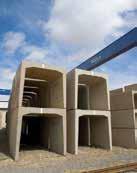

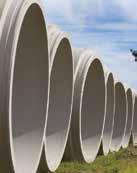
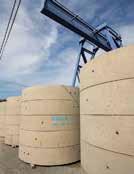
ROCLA is South Africa’s leading manufacturer of pre-cast concrete products. Surpassing 100 years of product excellence, including pipes, culverts, manholes, poles, retaining walls, roadside furniture, sanitation and other related products within infrastructure development and related industries.
Intake tower and access bridge
Downstream view of failed bottom outlet structure
Bottom outlet works at start of reconstruction
IFAT Africa 2019
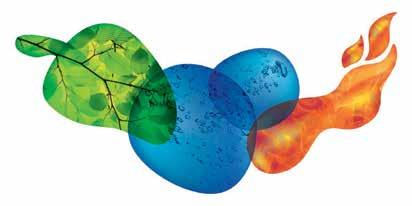
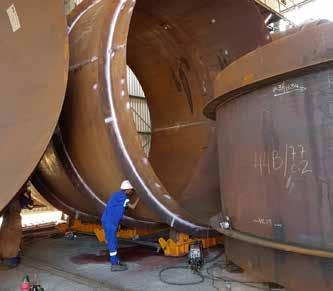
Administration of Water South (ARA-Sul) to engage its Emergency Preparedness Plan, thus mitigating possible risks to the community and property that would result from flooding of the dam.
The rehabilitated dam can now provide irrigation water for a total land area of 90 000 ha and provides employment opportunity to about 550 fishers, with an average annual catch of 3 350 tonnes.
Furthermore, the rehabilitation of the dam will facilitate the development of the Procana Sugar Irrigation Scheme, which will lead to the development of over 20 000 ha for sugar plantation and employment of about 1 000 people, while also being a catalyst for the development of associated agro-allied industries.
Tel : + 27 11 476 8093 Email : info @ mm-sa.com
Co-located:
IFAT Africa, food & drink technology (fdt) Africa and analytica Lab Africa bring to the continent the full spectrum of the technology behind water, sewage, refuse and recycling, food and beverage production, laboratory technology, analysis, biotechnology and diagnostics.
Presented by Messe Muenchen South Africa
for water, sewage, refuse & recycling

To achieve this positive outcome, Aurecon drew on its extensive previous experience in delivering cost-efficient and constructible major dam infrastructure projects in Africa. Through the collaborative attitude of the owner, ARA-Sul, together with the combined efforts of the consulting teams in Mozambique and South Africa, the best possible outcomes were ensured and the rehabilitated dam was successfully commissioned in early 2018.

Inside conduit during reconstruction
Inspection of welding on new steel liners (in the site factory)
Preventing water hammer
A unique, new flywheel water pump system offers the ability to mitigate the possible effects of water hammer by ensuring continued pumping in the event of power failures.
The pump was developed by KSB Pumps and Valves for the rural Tsomo District Municipality in the Eastern Cape, which is plagued by unstable electricity supply.
The municipality needed a product for critical high-lift pumping of potable water to supply water transfer requirements. However, the solution also needed to prevent the potentially catastrophic backward rush of water in the event of a power failure, which could lead to water hammer and the destruction of water infrastructure.
This required the technical team to develop a reliable and failsafe method of maintaining water pressure long enough to reconnect power or, in the event of no availability of power, to gradually slow down and arrest the flow without airbubble-causing cavitation. The rural location of the pump station also necessitated a reliable solution with minimal maintenance requirements.

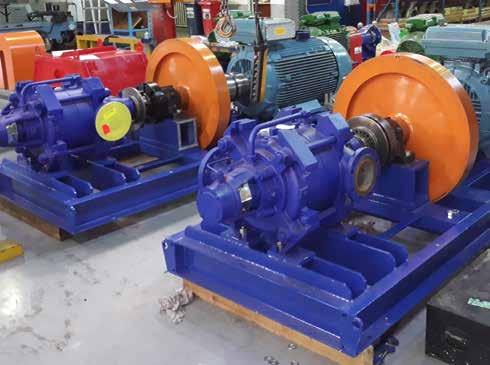
a smart solution
The requirements for a flow of 380 m3/h at a differential height of 261 m and an efficiency of 80.8% called for a powerful pump and motor combination with the addition of a heavy flywheel, explains Ruan Nel, project engineer, KSB Pumps and Valves.
“Weighing in at 681 kg each, the flywheels spin up to 3 000 rpm and provide enough momentum to pump water for at least four minutes after power is interrupted. With a flywheel central to the design chosen, the pump selection was based on our high-efficiency Multitec multistage pumps, which we configured in an inline orientation with the suction side on the left front side of the pump and discharge on the right frontside to make room for the flywheels,” he adds.
KSB also elected to manufacture all internal components in bronze for corrosion resistance and low maintenance as well as added durability.
“In the end, this is one of the only times worldwide that a flywheel pump of this size and such high revolution has been undertaken and paves the way to apply a smart solution to an old problem,” says Nel.
Meeting the challenge
Incorporating the flywheel was particularly challenging and required the flywheel component to be specially designed and manufactured to high standards with balancing to G2.5 at 3 000 rpm – a particularly close tolerance to ensure near perfect balance.
The system also requires a heavy-duty base plate made from channel type steel and reinforced around the flywheel plumber block pedestal to help ensure that the system remains perfectly balanced at all times.
Mating to the pump necessitated careful engineering, using self-centring ball bearings able to withstand high pressure, as well as special grease to allow for the high rpm. Operational bearing temperature was tested to remain at 19 to 21°C during extended operation, explains Nel.
The system uses a variable-speed drive to synchronise the motor, pump and flywheel speeds and makes use of specialised couplings to ensure the transfer of energy between the motor and flywheel remains seamless at all times, including start-up, power outages and restart while the flywheels are still turning.
Nel believes that the result of all of this is the kind of reliable, mechanical solution that is required in an isolated rural area like Tsomo.
The entire project was completed in just a few months – from order in October 2017 to acceptance in June 2018. “Our flywheel solution now ensures that the inertia of the flywheel keeps turning the pump and eliminates air pockets and water hammer if power is interrupted,” concludes Nel.
Ruan Nel, project engineer, KSB Pumps and Valves
The flywheel pump system that is able to mitigate the effects of water hammer during power failures


Sustainable water management Are prepaid systems the solution?

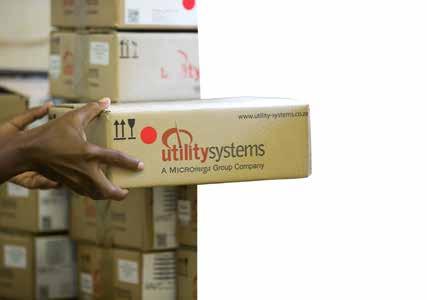
according to the WWF, 98% of the country’s water has already been allocated to users, leaving little surplus water to cater for a growing population and increasing demand.
One way to achieve sustainable water management is to understand and manage consumption by utilities and end-users. But, as it stands, we don’t have accurate data. Non-revenue water in our urban reticulation systems is roughly 37%, and consumers pay for consumption based on estimates and averages.
And while South Africa is the 30th driest country in the world, there is little awareness or incentive for citizens to use water sparingly. The average South African uses 235 litres daily, compared to a global average of 173 litres. One reason could be the country’s history of low water tariffs. Another could be that consumers don’t know how much they’re using until their statement arrives.
Prepaid water metering offers a solution, giving consumers financial control and enabling municipalities to measure, manage, and bill accurately and in real-time.
Prepaid perks for consumers
Information is key, and prepaid water meters provide this. When consumers know exactly how much water they’re using and what it’s costing, they can better manage their finances and handle leaks. Similarly, pay-asyou-go water systems give lower-income
Unless there is a drastic overhaul in water planning and conservation in South Africa, demand for this critical, but scarce, resource will surpass supply by 2020.
By Shannon Vermaak*
earners more financial control by enabling payment in smaller, more frequent increments. This prevents debt, which can compound on a post-paid arrangement.
Some prepaid systems also offer ‘lifeline’ or ‘emergency’ water. In exceptional circumstances, this allows users access to water when they’ve depleted their credit.
Prepaid perks for providers
Curbing municipal water losses should be a priority, not only because there won’t be enough water to go around in two years, but also because of the financial and economic implications. Water loss costs South Africa R7 billion a year, which could rather be spent to upgrade infrastructure and build more catchment facilities.
Aside from their ability to alert municipalities to leaks, prepaid meters also drastically reduce government’s admin costs. This is because municipalities don’t need to chase bad debts or budget for legal fees on unpaid accounts. Public sector cash flow is immediately improved because municipalities are paid up front for water.
Collecting data from prepaid meters is also more efficient than the manual collection required for post-paid meters. A radio link receiver can be fixed, mounted on a vehicle, or carried by municipality personnel. Data is transmitted to the receiver as soon as it’s within range of signal of the meter, so meter readers don’t need to enter the property. This facilitates walk- or drive-by meter reading and the capturing/navigation of routes.
Prepaid systems are also cost-effective solutions to sustainable water management in that
they have a low cost of acquisition. And by curbing water usage, capital recovery is possible within months. The systems are also able to distribute water equally, based on free water quotas, water balancing and fluctuating demand.
Finally, sectional title management companies can bill more accurately with prepaid systems, instead of splitting consumption equally between units within a complex.
Weighing pros and cons
As with any other prepaid service, if users don’t monitor their usage and credits, their water supply could be cut off.
While prepaid systems are more expensive than conventional metering, this is outweighed by the convenience of financial control, having real-time visibility into consumption via an app or user interface unit, and being able to identify a leak well in advance of it becoming a financial burden.
Municipalities that have implemented prepaid systems are seeing value from the ability to track usage and stop water flow once a limit has been reached, especially in drought-stricken areas. And since these devices are tamper-proof, municipalities can curb theft and better manage service delivery in under-served areas.
*ShannonVermaakisthemarketing manageratUtilitySystems.
Utility Systems’ utiliMeter uses next-generation advanced metering infrastructure technology
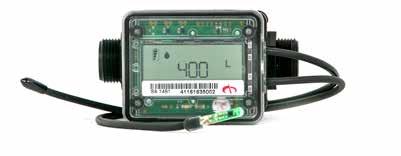

Sludge’s untapped potential
Electricity has become one of the biggest expenses for most of South Africa’s wastewater treatment works; however, most treatment plants possess an untapped renewable energy source that is not being harnessed.
electricity has been relatively cheap and reliable in South Africa for the past several decades. But as the cost of electricity continues to rise and supply becomes increasingly unreliable, wastewater treatment works (WWTWs) face a new challenge.
According to Dr Marlene van der Merwe-Botha, director, Water Group Holdings, electricity is now the second highest cost item on the budgets of energy-intensive
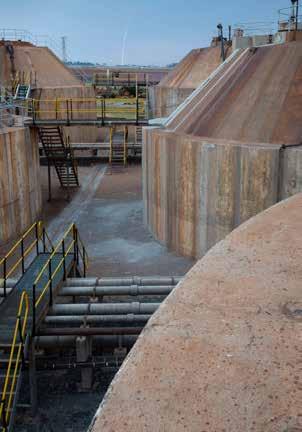
WWTWs (i.e. activated sludge and extended aeration).
However, the methane-rich biogas produced via anaerobic digestion (AD) at these plants presents an untapped renewable energy resource with several prospects for the South African wastewater industry. At the same time, the sector must be mindful that the skills necessary to operate anaerobic digesters need to be addressed in order to tap into this resource.
Harnessing biogas
The use of biogas is not a new concept, but it is one that has not yet been fully explored and embraced by South Africa’s wastewater treatment community. WISA, together with partners Salga, the Deutsche Gesellschaft für Internationale Zusammenarbeit (GiZ), and the Department of Energy (DoE), hopes to change this.
Although feasibility studies confirm a high potential for biogas-to-energy uptake in the South African municipal sector, several critical steps are required before a municipality should invest in a biogas plant. Apart from conducting detailed feasibility studies and concluding cost-benefit analyses, the upstream sludge management processes and operation of ADs need to be optimised.

To this end, the South AfricanGerman Energy Programme (Sagen), implemented by GIZ, supported the development of a practical guideline
called Anaerobic Digestion of Municipal Wastewater Sludge by Van der Merwe-Botha, in cooperation with Salga. The guide demonstrates the relationship between maintenance, design, operation and business processes, and how they should work together to ensure that an AD is capable of producing biogas and biosolids of the highest quality.
it’s all in the sludge
The overall sense in the industry is that the state of the country’s WWTWs is declining. Various industry roleplayers argue that the inaction in the roll-out of the Green Drop certification programme is unfortunate, with the most recent report being that of the 2013/14 audits.
“The programme was excellent at framing the state of wastewater services in South Africa; without it, we only have snippets of what is happening. We need verified, audited information to acknowledge the municipalities that continue their sterling work and those that are failing their mandate and putting people and the environment at risk,” says Van der Merwe-Botha.
The Green Drop is highly valued by municipalities, which use the results to motivate for the funding and skills needed to effectively run their WWTWs and to comply with effluent and sludge quality standards.
Currently, water institutions in South Africa follow a risk-based approach and most have a wastewater risk
Photographs
by Brett Eloff, ©GIZ
abatement plan (W2RAP) in place. From these, it can be identified that one of the highest risks for plant failure is sludge management. “This very same risk presents a considerable opportunity to wastewater practitioners. Many plants are simply ‘sludged up’ across the various process units that are designed to separate the liquids and sludge phases for further treatment.
“You can’t treat the liquid stream effectively if the sludge saturates the liquid phase. In the end, the final effluent quality will not be compliant, regardless of how much the process controller recycles, aerates or disinfects. Ultimately, our rivers and dams become sinks of the partially treated or untreated sludge,” explains Van der Merwe-Botha.
To comply with final effluent quality requirements, all sludge treatment processes must be monitored and operated efficiently to ensure they perform to expectation. Only then can WWTWs plan to produce their own electricity and heat, thereby saving on costs and reducing their reliance on Eskom.
However, not all plants are financially viable for combined heat and power (CHP). To assist municipalities in assessing the potential, Sagen funded the development of a decision-making tool by WEC in cooperation with Salga and GiZ.
“By making this easy-to-use tool available, municipalities can take the first step towards realising the potential utilisation of biogas from their treatment plants,” says Dr Sascha Thielmann, programme director, Sagen.
beNefits of cHp at feasible WWtWs
• Generation of renewable energy from a waste product
• Reduction in carbon emissions, noting that most SA plants do not flare or utilise the biogas
• Economical on-site electrical power production through biogas combustion
• Production of heat from the CHP engines, for on-site use or to be sold
• Production of a low-carbon fertiliser or soil conditioner
• Cost-effective, proven technology
• Opportunity for co-digestion with other organic waste
• Showcasing of political will to drive green energy initiatives, implement renewable energy projects and position forward-thinking, pro-environmental concepts

Work by Water Group, in cooperation with GiZ and the DoE, showed that WWTWs can be broadly classified into three CHP categories, depending on the state of infrastructure:
• category a: CHP ready (plug and play)
These plants have all the necessary civil, mechanical and electrical equipment in place, and a CHP module can virtually be plugged into the existing plant. Typically, such plants are equipped with primary settling tanks, high-rate (mixed and heated) ADs for primary and secondary sludge, gas collection systems with biogas holding tanks, hot water boilers, heat exchangers, etc. All systems are operable and in a fair to good state of repair. These plants present ‘best case’ plants with minimal additional costs and short implementation timeframes involved.
• category B: Upgrade
These plants require the moderate refurbishment or installation of additional components and processes
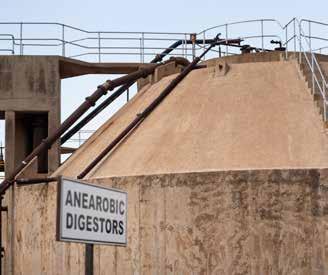

before CHP can be installed. These will be costlier than Category A plants, but are still highly viable.
• category c: Rehabilitate
These plants are equipped with civil structures and ancillary equipment in poor and inoperable condition, but are still viable for CHP. The anaerobic sludge digestion and biogas collection system requires complete rehabilitation, major refurbishment and intensive capital investment to effectively accommodate CHP. Van der Merwe-Botha says the team has already identified WWTWs where CHP is financially feasible, and the aim is to take the first steps towards achieving energy production within the next five years. She reflects that these plants can produce > 30% of their electricity needs from CHP. Other plants can become 100% selfsufficient and even have excess energy


Attendees at WISA’s pilot AD training course










www.infrastructurene.ws





OVER 100 000 visitors every month


+




TUse our rich media solution – video, animation and text – to reach and engage with your target market.
Rich Media can be used in our: Digimags Newsletters Website
ADVERTISE Jenny Miller on +27 (0)11 467 6223 or jennymiller@lantic.net
SUBSCRIBE TO DIGIMAG +27 (0)11 233 2600 or subs@3smedia.co.za SIGN UP FOR NEWSLETTER www.infrastructurene.ws FOLLOW US infrastructurenews @infrastructure4
www.3smedia.co.za

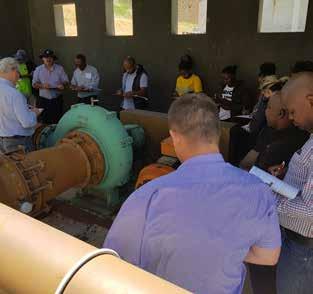

to feed back into the electrical grid, especially in cases where co-digestion can be implemented in cooperation with nearby industrial partners. Most ADs have insufficient substrate feed and have capacity available to source nearby organic waste to produce additional electricity.
She also argues that the focus on energy optimisation at WWTWs should follow a two-pronged strategy. “A WWTW can produce electricity through CHP and reduce energy use through energy-efficiency optimisation,” she explains.
Tackling climate change
In addition to cutting down on energy costs, implementing CHP and reducing energy demand at WWTWs has major climate change impacts. When it comes to greenhouse gas emissions, methane has a negative impact with an emission factor 21 times that of CO2. Few plants in South Africa flare off the biogas they produce, sending methane straight into the atmosphere. By harnessing these gases to produce heat and electricity, WWTWs can position themselves to combat climate change as well as open the door to new climate change-focused funding opportunities.
The skills shortage
“We have lost a lot of knowledge and operational skill in South Africa pertaining to sludge handling. Our legislation is primarily aimed at effluent quality, and the focus on sludge management was neglected until recently, when we introduced risk-based planning and identified sludge as a major problem area. If we fail in terms of sludge handling, then we fail on final effluent compliance and forfeit the tremendous opportunities to generate energy and reuse the nutrient-rich biosolids and effluent,” says Van der Merwe-Botha.
WISA will, therefore, be rolling out two mainstream training courses in 2019 focusing on:
1. Wastewater sludge management, anaerobic digestion and plant optimisation
2. Conducting energy audits at a WWTW, identifying areas and means to reduce energy consumption.
The training course
The CPD-accredited, two-day courses on ADs are split into theoretical and practical sessions, and include a site inspection and scorecard. The training focuses on several core elements required to have a capable anaerobic digester able to produce heat, electricity, good biosolids and quality effluent, namely:
• maintenance
• design and technology
• management
• operation and process control
• upstream sludge handling processes.
The courses will be directed towards enhancing the skill of wastewater practitioners, as well as the development of new trainers through ‘train-the-trainer’ courses.
“In this way, AD is at the centre of the water-food-energy nexus, and we can truly say that we are applying innovation, upskilling our human resources and starting to respond to climate change in a pragmatic manner. This is a real, sustainable solution, not a band-aid approach. But we have to start at the bottom with the basics, and work our way up to sustainable wastewater treatment in South Africa,”
Van der Merwe-Botha concludes.
Forenquiriesrelatingtothetrainingorcoursematerial, pleasecontact:
DrMarlenevanderMerwe-Botha–marlene@watergroup.co.za
AnitaPillay–training@wisa.co.za
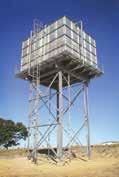

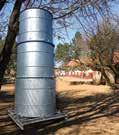

Pressed Steel Sectional Water Tanks
Specialists in the manufacturing of domestic and industrial water storage
Robust steel tanks specifically intended for rural, domestic, industrial and agricultural water storage needs.
The course includes a practical session with a site inspection

Decentralisation: the answer to sa’s water challenges
South Africa is in a water crisis and wastewater reuse, desalination and potable water quality are top of the agenda. Where will our future water be sourced?
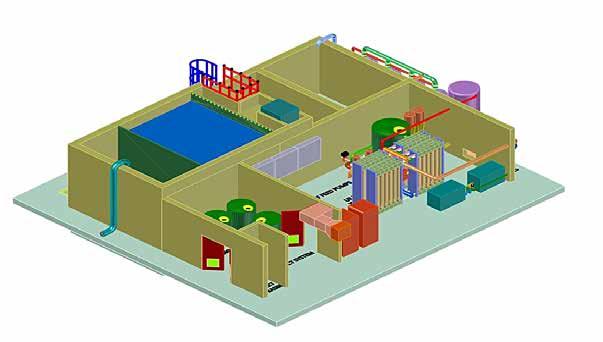
The most common solutions to South Africa’s water challenges usually entail a massive infrastructure capital spend and long-term implementation. The belief that scale always brings down the unit costs leads to focus on centralised water catchment and treatment – the bigger, the better, the cheapest and the easiest to operate. In looking towards megaprojects to solve the entire South African water crisis, we tend to forget about the smaller, easier projects that can assist with water supply. With failing infrastructure, which includes the pipelines transporting water for hundreds of kilometres across the country, decentralised water treatment starts making sense for smaller, remote communities or industry.
Advanced technologies provide a smaller footprint, less operator involvement and less dependency on chemicals for water treatment. QFS has brought globally leading technologies to South Africa and localised them to be more affordable for South African applications.
Wastewater reuse
There are a number of small wastewater facilities of between 1 MLD and 5 MLD scattered throughout South Africa. Most of the water at these facilities is not seen as a source but as an environmental contamination risk.
Rural wastewater facilities compete with many other services for the budgets of local authorities and are often neglected, suffering from insufficient maintenance and incorrect operation. The wastewater facilities are also under pressure to produce water good enough to release into a natural source. However, this ‘liability’ can be turned into an income stream, using the correct technology to produce safe irrigation or industrial water.
For the reuse process to be successful, there has to be infrastructure in place to biologically treat the raw sewage. The biological process must be able to produce water of acceptable quality for the reuse process to accept this for further treatment.
The process QFS offers modular, pre-designed
FIGuRE 1 Design of a compact treatment facility with all relevant technologies included
systems that can be installed with minimal site work. The following core technologies for water treatment are available:
1. Flocculation/clarifier
2. Drum screen @ 20 micron
3. Ultrafiltration (UF)
4. Advanced oxidation
5. Granular activated carbon
1flocculation/clarifier

A clarifier allows for flocculation to be included in the pre-treatment process. Chemical dosages will be confirmed during the final design phase, but typically three dosing stations are included for the addition of chlorine, pH correction and flocculants. The clarifier combats high solid carry-over from the treatment works and adds the ability for organic flocculation. Carry-over solids enter the clarifier and settle out with the assistance of installed tubular settlers, which utilise individual, isolated tubular channels. The modules are engineered with the individual tubes rising in the same
direction to eliminate mixing currents and unstable flow patterns. Structural ribs provide considerable vertical loading structural strength. The unique design insures a solid interface during installation.
Grating panels are installed on top of the tube settler packs to provide UV protection against extended exposure to sunlight. The grid also replaces a possible mobile walkway, as well as providing a protective layer from foot traffic and the repeated hydraulic impact of routine wash-downs.
2
d rum screen @ 20 micron
Clarified water will overflow to the drum screen in a concrete channel. The drum screen filters from the inside of the drum to the outside using gravity pressure. Screened water will fall into the UF buffer tank. The drum is fully automated and automatically cleaned with a set of nozzles, and cleaning commences as soon as the drum starts turning.
3 Ultrafiltration
UF is seen to be a core technology in the reuse process. The fixed removal rating of the UF membrane ensures the removal of pathogenic organisms, even those that are chlorine resistant. Each UF membrane filtration module comprises of a bundled group of hollow fibre membranes, surrounded by a protective plastic screen and sealed with polyurethane ‘pots’ at both ends. The pots allow filtered water to pass from the hollow inner core, or lumen, of the membrane fibres to the filtrate pipe sets.
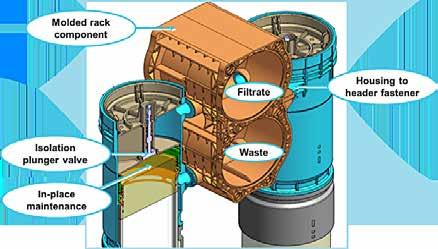
QFS’s Memcor L20 module housing acts as a pressure vessel for each membrane filtration module. Each L20 module house has two headpieces, two outer sleeves and a centre tube. Valves in the headpieces isolate both the inlet feeds and the filtrate outlets.

pressure vessels. Water will enter the vessel from the top and exit at the bottom.
In filtration, feedwater enters the module array through the feed ports in the end pipe sets, passes into the filtration modules, and through the membranes. Filtrate exits the module array through the filtrate ports and pipework flowing to the filtrate storage tank or service discharge point.
4
a dvanced oxidation
The advanced oxidation process of ultraviolet radiation in combination with hydrogen peroxide (UV/H 2O 2) is well understood and documented. The H 2O 2 is dosed after the carbon filters and before the UV light.
5
Granular activated carbon
The granular activated carbon media filter consists of modified steel
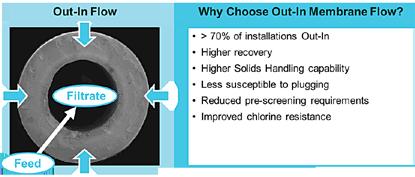
Backwash will be performed by a flow reversal and four filtration flow rates used for proper fluidisation of the media bed.
The granular activated carbon is made of selected virgin coal, produced under high-pressure extruding and strictly controlled steam activation processes at a high temperature. This granular activated carbon is characterised by a large surface area, uniform pore structure, high hardness, enhanced filtration and regeneration ability.
c onclusion
Herman Smit, MD of QFS, believes the above system provides the best solution for decentralised water reuse projects to supply irrigation or industrial water from wastewater treatment works.
“QFS has represented Evoqua (formerly Siemens Water Technologies) in South Africa for over 14 years, and has successfully implemented potable and wastewater projects. We are well positioned to provide equipment through our in-house manufacturing and implementation, and our personnel are familiar with all of the technologies required,” says Smit. “QFS is also available to work with the client should any changes be required during the final design stage of the project.”
FIGuRE 2 Ultrafiltration module housings
FIGuRE 3 Filtration in hollowfibre membrane
Reinventing sanitation
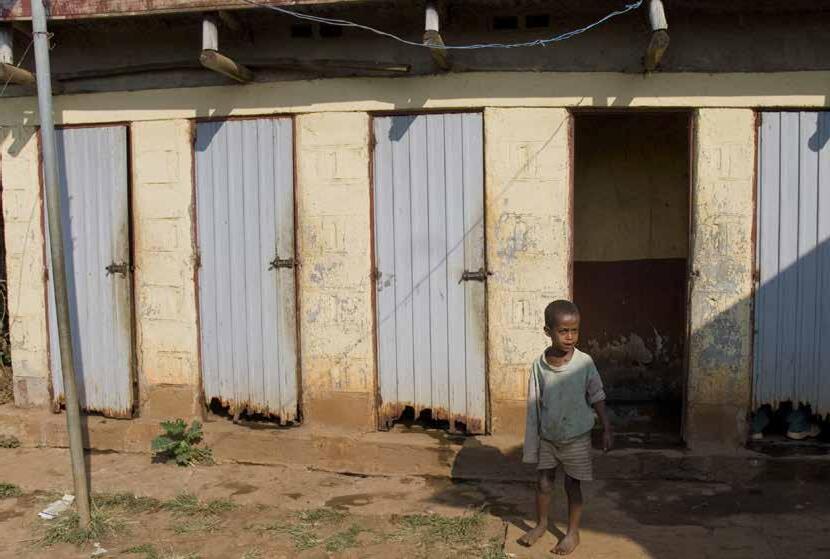
As the world turned its focus towards sanitation solutions on World Toilet Day, South Africa was faced with a shocking statistic: more South Africans have cell phones than toilets.
By Danielle Petterson
despite improved access to sanitation facilities, many South African households are still without adequate sanitation facilities, and in some cases, any facilities at all.
Stats SA reports that 45.6% of households do not have a
toilet inside their dwelling. And of the 75.5% of the population with access to ‘adequate’ sanitation, 12.2% are using pit latrines. When one considers that 93.6% of South African households have a cell phone, the lack of sufficient and appropriate sanitation is a major concern.
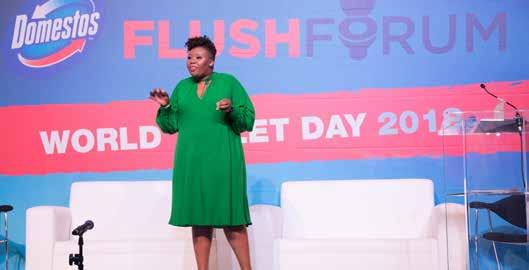
“It’s an everybody problem. We have to be better.” Anele Mdoda, Domestos World Toilet Day Ambassador
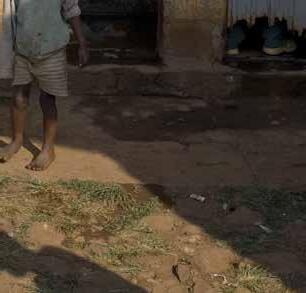
Sanitation in schools
Even more concerning is the state of sanitation in South Africa’s schools. Up to 7 000 public schools rely on inappropriate toilets and 2 000 have no toilets at all. In almost 4 000 cases, these ‘inappropriate’ toilets are pit latrines.
On World Toilet Day 2018, Unilever and its brand Domestos hosted the Flush Forum in an effort to heed the President Cyril Ramaphosa’s call for collective action to help solve the country’s school sanitation crisis. Here, delegates heard a call for ‘Pit Zero’ –the complete eradication of pit latrines. Earlier this year, five-year-old Lumka Mkhethwa drowned in a pit toilet at Luna Primary near Bizana, Eastern Cape. Around the same time, the family of Michael Komape lost its claim for damages following his death. Also five years old, Komape drowned in a pit latrine at Mahlodumela Primary School outside Polokwane, Limpopo, in 2014.
In an emotional address, Domestos World Toilet Day Ambassador Anele Mdoda spoke of little Mkhethwa, urging South Africa to do better when it comes to sanitation. “There is nothing comfortable about the fact that the children in this country can walk into a toilet and are faced with faeces and urine on the floor and they need to navigate in school shoes that they may not have. This is not a Domestos problem, or a government problem –it’s an everybody problem. We have to be better,” she said.
Ramaphosa, too, spoke of Mkhethwa and Komape when he launched the Sanitation Appropriate for Education (SAFE) initiative in August last year. The initiative, led by the Department of Basic Education in partnership with the National Education Collaboration Trust and the Nelson Mandela Foundation, is a response to the significant school sanitation challenges facing some of the country’s poorest schools.
that can help us to bring the costs of this exercise down,” he said at the Flush Forum.
Also representing the Department of Basic Education, Dr Granville Whittle, deputy director general: Care and Support Services, noted that there are four main reasons why children miss school in South Africa. Of these four, three of them are directly linked to sanitation, namely diarrhoea, colds and flu, and respiratory issues. “And so sanitation actually lies at the heart of the quality of education,” he said.

The SAFE initiative hopes to spare learners the indignity, discomfort and danger of using pit latrines and other unsafe facilities.
The reinvented toilet category is a US$6 billion-a-year sector
“We cannot expose our learners and educators to an environment that is not conducive to teaching and learning, and still expect excellent educational outcomes,” Ramaphosa insisted.
opportunity to meet the needs of 4.5 billion people worldwide.
“Opportunities of that scale don’t come along very often,” said software mogul turned philanthropist Bill Gates.
Back in 2011, the Bill & Melinda Gates Foundation launched the Reinvent the Toilet Challenge to develop a pipeline of next-generation, safe, off-grid sanitation solutions. According to Gates, 20 reinvented toilet and omniprocessor technologies and products are now available for commercial licensing and production.
South a frica as a
testing ground
According to Solly Mofoko, acting chief director: Infrastructure Planning, Department of Basic Education, sanitation is the department’s most urgent and important priority. “We have been granted a R2.5 billion budget for this but it is still not sufficient when you look at the enormous challenge we are facing. That is why these kinds
Reinventing the toilet
Most importantly, the sanitation solutions for South Africa’s schools cannot follow the traditional waterborne sewerage model. “The SAFE Initiative could be a catalyst for a new revolution in sanitation, demonstrating that these new systems can be effectively implemented at
Under grants from the Reinvent the Toilet Challenge, new ways of managing waste are being tested in Durban, South Africa. “Durban is a good place to run these tests because the city is growing fast and many people there don’t have modern sanitation, which means that even if they have access to a toilet, waste can get into the environment and make people sick,” explained Gates.
Many of the new sanitation approaches being tested don’t require water at all, while some don’t require electricity or run on solar power and, most importantly, they don’t need to be connected to the city’s sanitation system.
“Today, we are on the cusp of a sanitation revolution. It’s no longer a question of if we can do it. It’s a question of how quickly this new category of off-grid solutions will scale. We don’t know exactly how long that will take, but we do know it can’t happen fast enough,” said Gates.


A new model for pipe assessment
Cities around the globe are faced with deteriorating wastewater infrastructure. However, the resources are often not available to utilities to return infrastructure to optimal operating conditions.
By Danielle Petterson
in prioritising the renewal efforts of wastewater infrastructure, the best approach needs to be sought to identify which pipes to replace and when in order to avoid a more costly situation of completely failed infrastructure that must be restored.
According to Professor John Matthews, director of the Trenchless Technology Centre at Louisiana Tech University, this requires a risk-based decision-making approach. In order to determine the risk of an asset you need to know the probability of failure and the consequence of that failure.
Although pipeline assessments using technology like CCTV are fairly standard, wastewater pipe deterioration models are vital to effectively manage assets.
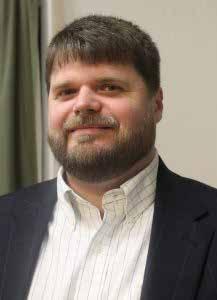

Matthews, together with PhD candidate Greta Vladeanu, has developed a new approach to determining the current and future conditions of wastewater pipes, and, ultimately, the probability of failure, for an efficient asset management programme. This uses a continuous-time Markov chain (CTMC) deterioration model using limited historical condition assessment data.
cTMc
A Markov chain is a stochastic model used to determine the probability of moving from a current, better condition, to a future, worse condition (i.e. deterioration over time). This can be measured in either discrete-time (DTMC) or continuous-time models (CTMC). Although most studies to date have used DTMC, Matthews argues
Professor John Matthews, director of the Trenchless Technology Centre at Louisiana Tech University
that, because deterioration happens continuously, even if it is not continuously observed, a CTMC approach is warranted. “We applied a continuous-time model instead of DTMC based on that premise. And so that is the unique thing about this model we developed,” he told delegates at the 2018 No-Dig Conference in Cape Town. When applying this risk model, the pair assumed that the pipe would be in one of three conditions:
1. As new
2. A certain level of deterioration, possibly requiring rehabilitation


3. Under threat of failure and in need of replacement.
The team then went on to develop a formula to determine the transition rate between these three conditions: q12 q23 1 2 3
Deterioration rates (q) from better to worse conditions can be determined from condition inspection data. Once a pipe is rehabilitated or replaced, it is taken out of the system and new condition assessment data is necessary to determine the deterioration rates of the new pipe material.
“The more date points you have, the better this transition rate matrix will be,” said Matthews.
case study
Although Matthew’s approach is still somewhat theoretical, it has been applied to an actual utility. The model has been tested at a Louisiana wastewater utility on 48 km of 200 mm of VCP pipe installed in 1965.
The utility had one-time CCTV inspection data from 2016, which provided pipe characteristic information such as material, length, diameter and age, as well as a series of other parameters such as flow control, pre-cleaning method and the location of pipe. This was compared with the pipe conditions at the time of installation to determine the transition rate matrix.
Determining the condition of each pipe segment was done using a condition rating model developed by Vladeanu as part of her doctoral dissertation.
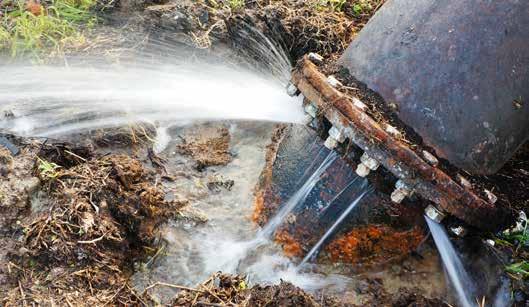
A 200-year probability of failure curve was then developed for the 48 km of pipe and it was determined that there was a 50% probability of failure at 86 years.
Limitations
Matthews explains that the large time gap of 51 years between inspections limits the abilities of the model. A shorter time span between inspections would improve the reliability of the obtained transition rates. In addition, although only two condition inspections at minimum are needed to develop the model, additional inspection is needed to validate the model.
It is also important to note that the probability of failure is determined for a pipe cohort, and not for individual
pipes. Therefore, depending on the application of the model, this might be a limitation. However, Matthews believes the model could be applied at a pipe level in combination with some kind of GIS asset management system that provides multiple inspection data.
True risk of failure
While this model proves effective in determining the probability of failure, it needs to be combined with a consequence model to determine the pipe’s true risk of failure.
“For true decision-making and to rank your pipes in terms of which ones you want to address, you have to do a full risk of failure.”



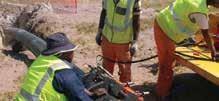
Combatting sulfate attacks
Concrete infrastructure is often exposed to aggressive environments in the water sector, leaving it vulnerable to the risk of sulfate chloride attacks.

Sulfates, especially in the form of salts of calcium, sodium, potassium and magnesium, are a challenge for concrete civil works in aggressive environments such as sewage plants, mines, and coastal areas where soils are high in sulfates.
Sulfates are said to ‘attack’ concrete because they can permeate the surface layers in solution with water. This reacts with unreacted C3A and calcium hydroxide in the cement paste, leading to the formation of various compounds that can be upto 600% more voluminous than the original chemicals.
As a result, the outer layer of the concrete suffers cracking, spalling and separation of aggregate from the cement paste. This leaves more surface area of the paste to react and exposes any reinforcing to corrosion.
finding a solution
“In years to come, faced with daunting refurbishment costs, it is no use thinking ‘if only’ we had built with different materials,” says Roelof Jacobs, manager: Integrated Solutions and Innovation, Lafarge. “Faced with the demands of high population growth and rapid urbanisation, we owe it to our communities to build
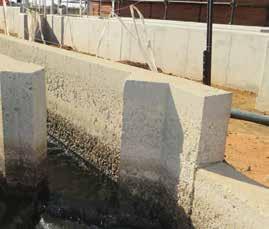
a longer service life in our concrete structures. We simply cannot afford to reconstruct or repair our raw, potable or wastewater infrastructure every few years.”
One of Lafarge South Africa’s latest cement innovations, Sulf8-CEM, offers a solution to the challenges associated with sulfates.
The low-heat (LH), sulfate-resistant (SR) cement is a CEM IV/B-V 42,5N LH SR pozzolanic cement formulated from Portland clinker with more than 36% selected quality siliceous fly ash, and C3A content in the clinker below 9%. The product also contains performance-enhancing additives. Sulf8-CEM has been certified to conform to the latest applicable South African and EU standards (SANS 50197-1and EN 197-1).
Low heat of hydration
According to Jacobs, Sulf8-CEM also offers a significant benefit as a classified low heat of hydration product.
The exothermic cement hydration reaction that rapidly raises the temperature of freshly placed concrete is not a problem in normal structures that allow the heat energy to dissipate easily. However, in large structures, the heat builds up, causing

high temperatures and expansion of the concrete while it is hardening.
The temperature differential between the interior of a mass pour and the cooling outer layers can generate sufficient tensile stresses to cause cracking. This not only reduces the bearing capacity of the structure but also creates entry points for harmful substances to penetrate the concrete.
As a result of the high quality and content siliceous fly ash in the formulation, Sulf8-CEM is an exceptionally good LH pozzolanic cement with a typical heat of hydration value of 166 J/g, tested at 41 hours as per EN 196-9. While this contributes to lower peak temperatures with lower temperature differentials and the associated tensile stresses in mass concrete, the peak temperatures also occur at a later age, by which time the concrete is more mature and better able to withstand any tensile stresses.
“We are extremely proud to have developed this all-round highperformance product, Sulf8-CEM,” says Jacobs. “At Lafarge, we set out to offer the water industry a solution for creating durable concrete structures suitable for use in aggressive environments.”

r eshaping concrete
Research into the effective use of effluent in concrete and concrete products is currently under way in Cape Town.
currently, no specific standards exist to allow the use of water other than that of potable standard in the concrete manufacturing process. However, the recent drought in the Cape region has spurred the Southern Africa Readymix Association (Sarma) to join forces with the City of Cape Town to use effluent in the concrete space.
The construction industry is a major water user and, in the case of concrete manufacture, cannot continue without a reliable supply of water. Water shortages can lead to the closure of concrete manufacturing plants or, as occurred in the Cape, to manufacturers sinking hundreds of boreholes. Unfortunately, this can eventually
lead to the concentration of salts that can render the water unusable for drinking or agriculture for future generations.
If a suitable solution using effluent is found, it will not only have a positive effect on water supplies and the environment, but will also reduce the cost of water for construction by as much as 75%, explains Johan van Wyk, director, Sarma.
Testing
The effluent that will be used will have undergone all cycles of treatment at a wastewater treatment plant except naturalisation in a maturation pond. This type of water, which is often used for irrigation, is also not made provision for in SANS 51008 (mixing water for concrete) because, until now, no specific testing has been done.
Sarma is currently compiling a test to run an eight-week study. The results, including chemistry and all the parameters surrounding the water, will be collated and the effluent’s effect on the mixing, setting, curing and strengths of the concrete will be monitored. This will then be compared with current concrete standards and data to make a finding.

“Our preliminary findings are positive and give hope for a major evolution in the way we make concrete in dry climatic regions,” says Van Wyk. On completion of the project, the findings will be made available and best practices shared with all concrete manufacturers.
“As guardians of future generations, we feel it is our responsibility to find sustainable alternative means of manufacturing concrete, which, in turn, will play a significant role in shaping our future and building infrastructure for the next generations.”
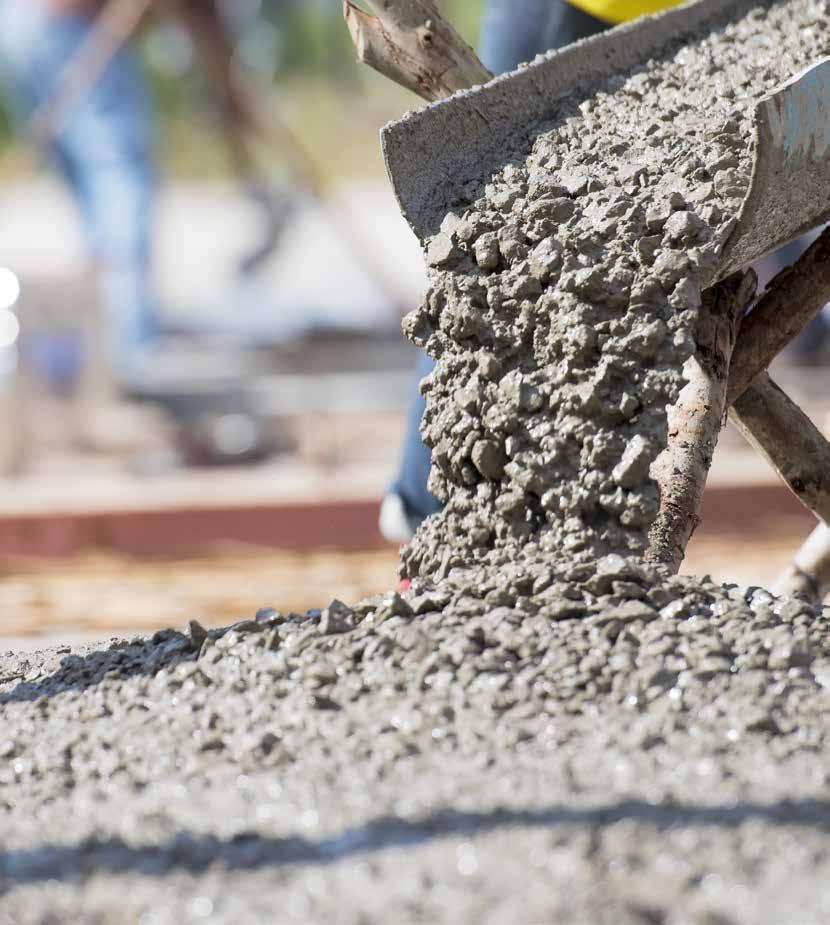
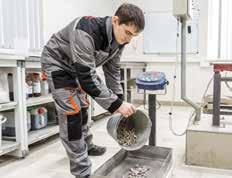


Johan van Wyk, director, Sarma
Enhancing WC/WDM enablers
ThispaperisthefourthinaseriesofsixarticlesbyDerekHazeltononWC/WDM.Theearlierarticlesappeared intheJuly/August,September/OctoberandNovember/December2018issuesofWater&Sanitationafrica (Vol.13No's4,5&6).

Having an initial implementation plan and budget are necessary pre-launch enablers for a WC/WDM project. Then, as soon as implementation begins, it is invariably necessary to ensure that the WSA’s


In Part 3 – ‘Planning and launching an integrated WSA WC/WDM project’ – it was explained that the sustainable implementation of WC/WDM is not possible without key enablers being in place. This article will recommend the general approach that should be used in enhancing these enablers. By
Derek G Hazelton
executive council and relevant staff have an adequate understanding of the importance of WC/WDM and are motivated to support its implementation.
As implementation progresses from subsystem to subsystem,
similar education needs to be extended to ward councillors, and community customers, schools, clubs and churches.
In addition to this general education, extensive skills and empowerment training of the WSA’s and communities’ human resources will need to be done progressively, as the need arises, so that the whole turnaround project and ongoing operations, monitoring, and maintenance can be done effectively, in a decentralised manner.

The recommended approach The central aims of WC/WDM are leakage reduction, improved cost recovery and any required additional reduction in the total water demand. If there is not a strong focus on
Derek G Hazelton, Pr Eng., FWISA, founder and manager of TSE Water Services
FIGuRE 1 Overview of integrated communications, control and information management systems
these central aims, the work done will not show any significant improvement towards the set targets. Without these improvements, it will be practically impossible to retain the backing of the WSA’s leadership for the project.
Short-term planning must, therefore, aim to show the maximum visible return on the expenditure. In the first two to three years, after the project launch, at least 50% of the project expenditure will need to be used directly to achieve the set targets. Thus, during these early years, other than the above education and skills training, enhancing enablers must have a low priority.
In contrast, if the project PSP does not convince the relevant stakeholders of the need for all enablers to be enhanced to a high level of excellence in the medium to long term, they will never be improved to the required level or, worse, the money will be spent on improving the enablers, but they will not be used. In either case, the WC/WDM
improvements will not be sustained. Team members’ living motto needs to be: learn what enablers you need, clean and optimise the use of what you have already, and only spend money on enhancing enablers you know you will use and use to advantage.
Living this motto in its entirety is the only way to ensure that, when the PSP hands back the responsibility of managing the infrastructure assets to the WSA and its communities, the targets already achieved will be maintained, and, if necessary, interim targets will be transformed, over time, into the highest economically achievable targets.
i ntegrated communications, control and information management
Figure 1 represents an overview of the integrated communications, control and information management systems needed to implement WC/ WDM efficiently and sustainably. An important feature of Figure 1 is the
depiction of the flow of information between the different systems. It is common practice for the municipal CFO to be responsible for the municipal financial management system (FMS). This practice is supported, so that the general financial management and billing functions for the municipality’s diverse revenue and expenditure streams can be integrated. However, the water services manager (WSM) needs all the financial information related to water services to manage them. Thus, all the FMS information must be available in the WSA’s integrated information management system (IIMS), without the WSM’s staff being able to alter this data. Relevant WSA reports should, of course, be sent to the CFO’s staff. When the CFO does not maintain accurate, up-to-date data, some WSMs insist on loading selected financial information directly into their IIMS. While this can be useful as a checking mechanism, the duplication of work is inefficient, and
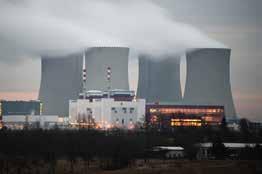

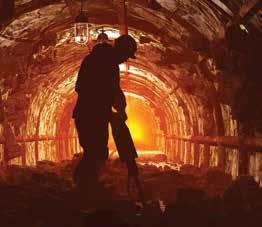



it is better if the municipal manager ensures the effectiveness of the CFO’s FMS.
All customer, and most community, information needs to be collected in a call centre. From there, the information must be transmitted immediately to the relevant municipal officer for action. Thereafter, as action is taken, the caller needs frequent feedback. This information flow is indicated by the arrows leaving and entering the call centre system.
The telemetry monitoring box represents the dispersed measuring instruments used to monitor the water supply systems. For sophisticated capital-intensive systems, the instruments are often fitted with data loggers and telemeters to transmit the logged data automatically to more centrally located receiving equipment.
For systems in poor and/or rural areas, it is frequently better to use in situ control systems, and community members, using cell phones for example, to send the necessary data to the required receiving points semimanually. When community members are sending the data, it is also often more effective for the community member to read the measuring instrument directly. This obviates the need for a data logger.
As well as reducing the capital and maintenance costs, such simplification can result in communities having a much greater hands-on understanding of how the system’s water and infrastructure needs to be cared for. This understanding further motivates communities to take the necessary care. Lastly, this community motivation and infrastructure simplification can reduce vandalism significantly.
The telemetry monitoring box has two arrows leaving it – one linked to the IIMS and the other linked to the control systems box. The direct link to the control systems improves the reliability of the controls and the direct link to the IIMS can be useful by initiating early warnings of a control system malfunction and/or failure. Note, a lesser arrow leaves the control system’s box, to link with the telemetry monitoring. Where necessary, this closes the control system loop.
f inancial management system
While the quality and management of the water supply services section of the FMS is an essential part of WC/WDM, it is uncomplicated. It comprises only two sections. The first section relates to the WSA’s customers and their water meters. This section must be accurate and kept up to date continuously. The second section relates to reading the meters and to all the resultant money flows. These records need to be completed monthly, accurately, comprehensively and timeously.
As the CFO’s office is usually responsible for managing the meter readers, it is recommended that this office also produces a meterreadings report, listing expected meter reading errors and customers whose meters have not been read.
i ntegrated information management
Always remember that the purpose of the system is to facilitate the optimisation of the WSA’s assets management, including WC/WDM, over their full life cycle. It must focus on what is to be managed, how it is to be managed, and the information and reports required to implement the management in an effective manner, compliant with the ISO 55000 standards and South Africa’s legislative and regulatory requirements.
Comments:
No WC/WDM turnaround project was being implemented in Beaufort West in 2014-15. As a result the avg monthly trendlines are reflecting a NRW deterioration.
Avg monthly charts are best for reflecting short-term warnings. Avg monthly charts for the previous 12 months are best for reflecting longterm trends.
Large WSAs will need help from a professional software and training provider to achieve this. The training will include providing help on how to load all the semi-constant infrastructure attributes, and the variable performance data into the system, as well as making the best use of the stored information for dayto-day operations, monitoring and maintenance, and for all water resources, technical and financial planning.
The biggest challenges are developing the information system with a limited yearly budget and limited human resources to operate and maintain the system.
The IIMS must be comprehensive because the WSM is responsible for the services delivery. All the FMS information that may be useful to the WSM should also be accessible via the IIMS.
The first section relates to the details of all the water services infrastructure. Like all data entered in any of the systems, it must be accurate and must be kept up to date when the infrastructure is expanded or modified. Therefore, apart from keeping it up to date, once all data related to the existing infrastructure has been accurately entered, no further data changes will be required for this section.
If the existing system is inadequate, the short-term focus should be on
Beaufort West Water System
FIGuRE 2 Monthly NRW monitoring for the Beaufort West water system 2014-15

loading the most useful data, while also prioritising the infrastructure related to the current annual WC/ WDM project implementation plan. Subsystem annual KPI targets, schematics, a basic infrastructure register, and GIS are normally urgently required. This initial infrastructure register may well not be mSCOA and GRAP complaint. Further details should be added as the budget allows and as the need for them arises.
Despite all infrastructure management manuals using ‘consequence of failure’ ratings, this author has not found them useful, except when designing or upgrading infrastructure. Then maximum ratings should be avoided, by maximising the use of ring feeds in the distribution systems and by installing standby units, for equipment with moving parts. If the WSA is currently making no use of GIS, free Google Earth Pro software should be considered. Multilayered information can be stored easily in this software.The second section mostly comprises records that need to be updated frequently. Calls and alarms requiring the implementation of unplanned maintenance need to be acted upon immediately. MNFs
should be logged semi-continuously, say every 15 minutes, and monitored every 24 hours, ideally using automatic alarms. Other records – excluding failure, condition, and risk criticality monitoring – should generally be updated and monitored monthly. Figure 2 shows monthly NRW monitoring for the Beaufort West water system for 2014-15.
The author has found carefully investigating the cause of repeated failures to be extremely useful. This should always be done before asset replacement or refurbishment is considered. With respect to condition and risk criticality monitoring, he has only found this to be worthwhile when applied to areas where it has already been established that the cause of failures is solely due to the asset being in a very poor condition.
But it must always be remembered that this updating is of no value unless it results in beneficial action. Thus, improving the operations and maintenance, with just enough information flow, updating and reporting to achieve this must be the objective. This objective will be achieved by information management concentrating on critical calls and alarms, and data related to the infrastructure and
its operational attributes that are currently being, or have already been, attended to as part of the WC/WDM turnaround project. Training and motivating communities to use the call centre greatly reduces the need for sophisticated measuring instruments, as does an information system that flags alarms and converts data into monitoring charts automatically. The third section refers to monthly and emergency management reports. These reports should be concise. They should also aim to motivate team members by highlighting successes, and to indicate clearly where implementation changes are required because set targets are not being met.
The fourth section refers to reports that should be produced or updated annually. Master planning often requires hydraulic modelling. Rather than the WSA having the software to do this, it may be more costeffective to forward the system details to a PSP, to carry out the required modelling.
Forafulllistofreferences, pleasecontacttheauthorat tsewater@icon.co.za.
WISA is committed to constantly improving its service delivery and the organisation’s new
ISO 9001:2015 certification is another step towards ensuring that members’ needs are met and prioritised.
According to Adrie Krugel , operations manager at WISA, the institute, under the leadership of CEO Dr Lester Goldman, places a strong emphasis on good governance and compliance with regulations. This means excellent customer service from grassroots level up, as well as customer-focused policies and processes.
ISO 9001:2015 aims to enhance customer satisfaction through the effective implementation of a quality management system, including processes for improvement of the system and the assurance of conformity to customer, statutory and regulatory requirements.
This ties in with WISA’s five core values – integrity, professional, community, trustworthy and innovative – and was the logical next step for the organisation in improving its customer satisfaction and corporate governance.
WISA became officially ISO 9001:2015 certified in September 2018.
Putting people first

effective quality management
The ISO certification focuses on seven quality management principles:
1. Customer focus
2. Leadership
3. Engagement of people
4. Process approach
5. Improvement
6. Evidence-based decision-making
7. Relationship management
WISA will now be continuously measuring and monitoring itself against these principles and conducting regular audits to ensure that processes are being followed. Any non-compliance, problems or customer complaints will result in corrective measures following a rootcause analysis.
Annual external audits by an objective third party also provide members with the assurance that policies are followed, measured, monitored and managed to ensure compliance.
“It is no good having policies if they are not followed. This ISO certification ensures that we adhere to our policies and
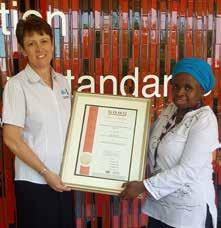
constantly look for new ways to improve them,” says Krugel. “Every staff member has a role to play and is measured against our client care policy. It is a team effort and we’re all in it together.”
Building on effective processes
The ISO9001:2015 certification builds on some of the initiatives the organisation already had in place to ensure the best service delivery.
WISA’s annual customer satisfaction survey provides members with the opportunity to give feedback, make suggestions, and voice their concerns. This feedback is used to determine whether members are still satisfied, find areas of improvement, and inform WISA’s annual strategic planning session.
Krugel also encourages members to reach out to her at clientcare@wisa.org.za if they have any complaints, compliments or suggestions they would like to raise. All complaints will be recorded and investigated, and remedial actions will be taken.
Dr Goldman is confident that the ISO certification will go a long way to build on this: “I am pleased to announce that we finally have our ISO 9001:2015 certification. This will help us ensure that we continue to deliver the very best service to our members and ultimately achieve our vision – inspiring passion for water!”
Adrie Krugel, operations manager at WISA, receives the ISO9001:2015 certificate from Phyllis Mathope, planning coordinator at SABS

